|
|
From http://www.uriarte.dk/porsche944 |
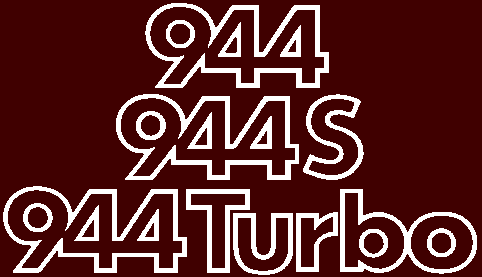 |
Owner's Manual |
|
|
IMPORTANT For your own protection and longer service life of your car, please heed all operating instructions and special warnings. Ignoring them could result in serious mechanical failure or even physical injury. |
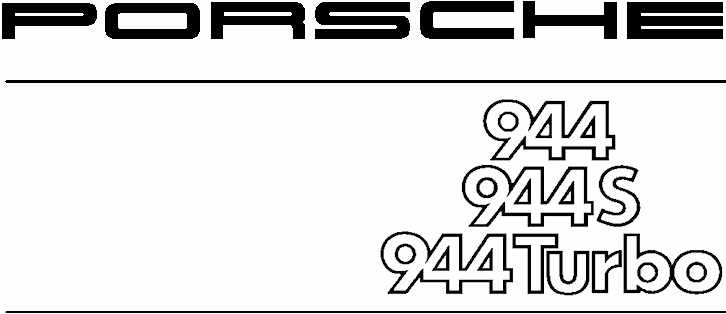
© Dr. Ing. h. c. F. Porsche Aktiengesellschaft All rights reserved. Printed in Germany Your car may have all or some of the components described in this manual. Should you find explanations of a feature or equipment not installed in your car, your Porsche dealer will be glad to assist you. Also check with your dealer on other available options or accessories. Text, illustrations and specifications in this manual are based on the information available at the time of printing. It has always been Porsche's policy to continuously improve its products. Porsche, therefore, reserves the right to make changes in design and specifications, and to make additions or improvements in its product, without incurring any obligation to install them on products previously manufactured. |
||||
|
NOTE TO OWNERS In Canada, this manual is also available in French. To obtain a copy contact your dealer or write to: |
NOTE AUX PROPRIETAIRES Au Canada on peut se procurer un exemplaire de ce Manuel en fran- gais aupres du concessionaire ou du: |
||||
|
|||||
| 1 | |||||
|
Judging by the car you have chosen, you are a motorist of a special breed, and you are probably no novice when it comes to automobiles. Remember however that, as with any vehicle, you should take time to familiarize yourself with your Porsche and its performance characteristics. Always drive within your own unique capabilities as a driver and your level of experience with your Porsche. Ensure that anyone else driving your Porsche does the same. To prevent or minimize injury, always use your safety belts. Never drink alcohol before or while driving. This Owner's Manual contains a host of useful information. Please read this manual before you drive your new Porsche. Acquaint yourself with your car's features and know how to operate your Porsche more safely. The better you know your Porsche, the more pleasure you will experience driving your new car. A separate Warranty and Maintenance booklet explains how you can keep your Porsche in top driving condition by having it serviced regularly. |
It also contains detailed information about the warranties covering your Porsche. These warranties are: "Warranty for new Porsche vehicles", "Warranty against corrosion for new Porsche vehicles", "Warranty for new Porsche vehicle emission control system", "Emissions performance warranty" (USA only), and "California emission control system warranty" (California USA only). In order to keep your warranty in effect, you must have the vehicle maintained and serviced as prescribed in the Warranty and Maintenance booklet provided to you at the time of sale. Always carry your Warranty & Maintenance booklet with you when you take your Porsche to an authorized dealer for service. It provides your Service Adviser with the information he needs and enables him to record each service. If you sell your Porsche the Owner's Manual and the Warranty & Maintenance booklet should be left in the vehicle to make all operating safety and |
maintenance information available to the next owner. If you change your address or if you bought this Porsche used be sure to send in a "Notice of Address Change"/ "Notice of Used Car Purchase" post card. This card can be found in the Warranty & Maintenance booklet or obtained from your Porsche dealer. It is in your own interest that we can contact you, should the need arise. In case any adjustments or modifications need to be made to your Porsche to maintain its safety. For your own protection and longer service life of your car, please heed all operating instructions and special warnings. Ignoring them could result in serious mechanical failure or even physical injury. We wish you many miles of safe and pleasurable driving in your |
||
| 2 | ||||
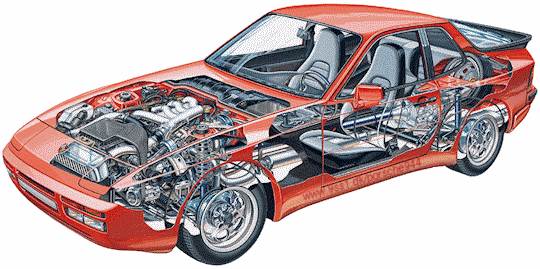 |
| 3 |
|
INDEX A ABS Acceleration diagram Accelerator pedal Air Bag System Air - cleaner - conditioner - filter Alternator warning light Antifreeze Antilock, Brake system Anti-theft alarm Ashtray Automatic- garage door - speed control - transmission - transmission fluid B Battery Boost pressure gauge Brake - booster - fluid - fluid warning light - pads - parking - pedal - system - warning light Break-in hints Bulb replacing Buzzer |
28,39 118-129 55 20, 21, 38, 39 80, 81 44-46 80,81 39 74,75,110 28, 39 11 42, 98 25 29 53-55 78,110,128 90-92 34 27 39,79,110 39 27,37,47,79,80 26 26, 27 26,27,115 37 47 93-98 10,18,24,30 |
C/D CASIS Capacities Car care instructions Casis Catalytic Converter Cautions Central locking Central warning light Cigarette lighter Cleaning Clock Clutch pedal Collapsible spare tire Control warning light system Coolant Temperature Gauge Cooling system Corrosion prevention Dashboard Defogging/defrosting Dimensions Doors Driving hints E/F Electrical system Emergency- flasher - starting Emission Control System Engine - cooling - exhaust - hood - number - oil checking & changing - oil -speed, max |
35 110 61-66 35 50,102 67 13 37 41 61-66 40 27 85 36-39 36 74-77 65-66 24 44-46 114 12,13 8-9, 48, 49 89-92 41 92 100-103 74-77 48 58 6 69-72 69,110,111,128 34,47,52,106-108 |
Fan control switch knob Fan, radiator Filling capacities Fog lights Fuel - economy - evaporation control - gauge - recommendation - tank Fuses and relays G/H Gas Station Information Gasohol Gasoline Gear ratio diagram Gearshift lever Glove compartment Hatchback Headlights Headlight- dimmer - flasher - switch - washing system Heater/ventilation controls Hood - front - rear Horn I/J Ignition/steering lock Instrument illumination Instruments Interior ligh |
44 36, 74 110 30, 96, 97 49 103 37 50, 51 50,110 89,126 126-129 51 50,51 122-125 52-55 42 56 30,95,99 30 30 30 31,32,81,110 44-46 58 56,57 21,24 24 30 33-40 43, 98 |
||
| 4 | |||||||
|
Jack - supports K/L Keys Kickdown Lane changer Leather License plate light Light switch Lights - ashtray - fog - interior - license plate - parking - turn signal Locks - doors, wheels Loudspeakers Lubricants Luggage compartment M/O Manual transmission - oil Mirrors Oil- change - consumption - filter changing - pressure gauge - pressure warning light Octane rating Oxygen Sensor P/R Paint code number |
68 87, 88, 129 10-11,86 55 30 65 98 30 98 30, 96, 97 43, 98 98 30, 37, 93, 94 30,93,94 10-13, 86 89 110,111 57 52,122-125 77,110 22,43 71,72 47, 69 71, 72 38 38 50, 51,106-108 101,102 7 |
Parking- brake - lights Performance Power assisted steering Power train Power windows Prop-up roof Radiator fan Rear - hood - view mirrors - window defogger - wiper Recirculation Switch Refrigerant Relays Rims Roof racks Roof, removable S Safe driving hints Safetybelts Safety belt warning light Safety compliance sticker Seat heating System Seats Sekuriflex windshield Shift indicator Shift points Side marker lights Ski racks Snow- chains - tires Spare tire, collapsible Spark plugs Specifications, engine |
26, 37 30,37,93,94 116 73 109 12 59, 60 36, 74 56,57 22 41 42 44 46,110 89,126 64,112,113 57,114 59, 60 8-9 17-21,65 18,37 7 15 14-16 31, 63, 64 35 52-55 94 57,114 83, 84,112,113 83,84, 111,113 85 106-108 106-109 |
Speedometer Starting procedures Sun visors T/U Tachometer Technical data Tirepressure Tires Tool kit Trip odometer Transmission oil Trunk Turn signal lights Undercoating Unleaded fuel V/W Vehicle identification Ventilation Voltmeter Warning/indicator lights Washer reservoir Washing Water temperature gauge Weatherstrips Weights Wheel alignment Wheel nuts, lockable Wheels Wheel changing Windows Windshield- washer reservoir - wiper/washer lever |
33 24, 25 43 34, 35 105-125 82,112,113,129 47,82-87,112,113 68 33 77, 78,110 56,57 30, 37, 93, 94 65, 66,100 50, 51,106-108,110 6-7 44-46 38 35-40 81,110 61-66 36 64 114 115 86 47,64,82-87,112 85-88 12,63,64 81,110 31 |
||
| 5 | |||||||
| Location of Vehicle Identification Number, Paint and Engine Number When ordering spare parts or submitting inquiries, always quote vehicle identification and engine number to assure correct and prompt service. |
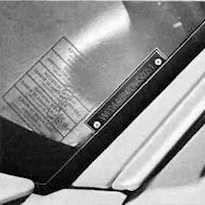 |
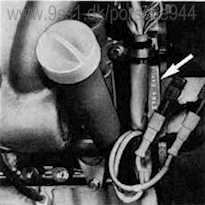 |
||
| Vehicle Identification number In accordance with Federal Safety Regulations, the vehicle identification number of your car is located on the left* windshield pillar and can be seen from the outside. Throughout this booklet and other Porsche publications applicable to USA vehicles, left is designated as the driver's side of the vehicle, and right as the passenger's side of the vehicle. |
Engine number The engine number is stamped on the left side of the crankcase next to the clutch housing. |
|||
| 6 | ||||
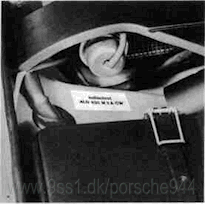 |
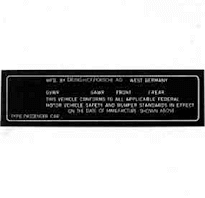 |
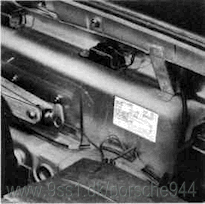 |
||
| Paint number The paint number sticker is on the left side of the engine compartment, to the right of the central electric box. |
The Safety Compliance Sticker is your assurance that your new Porsche complies with all applicable Federal Motor Vehicle Safety Standards which were in effect at the time the vehicle was manufactured. This sticker is located on the left side of the engine compartment to the left of the central electric box. The sticker also shows the month and year of production and the vehicle identification number of your car as well as the Gross Vehicle Weight Rating and the Gross Axle Weight Rating. |
The Vehicle Identification Label is located under the luggage compartment carpeting and attached to the rear panel next to the left tail light housing. This label contains the following information: 1. Vehicle Identification Number 2. Vehicle Code 3. Engine and Transmission Code 4. Paint and Interior Code 5. Option Codes A duplicate of this label is in your Warranty and Maintenance booklet. |
||
| 7 | ||||
| Dear Porsche Owner |
Before going on a trip... |
|||||||||||||||||||||||||||||||||||
| A lot has gone into the manufacture of your Porsche, including advanced engineering techniques, rigid quality control and demanding inspections. These engineering and safety features will be enhanced by you... the safe driver... who knows his car and all controls who maintains his vehicle properly who uses his driving skills wisely, and who always drives within his own capabilities and his level of familiarity with his vehicle. You will find helpful hints in this manual on how to perform most of the checks listed on these pages. If in doubt, have these checks performed by your Porsche dealer. |
First things first
|
It is good practice to carry emergency equipment in your vehicle. Some of the things you should have are: window scraper, snow brush, container or bag of sand or salt, emergency light, small shovel, first-aid kit, etc. |
||||||||||||||||||||||||||||||||||
| 8 | ||||||||||||||||||||||||||||||||||||
| In the driver's seat... |
On the road... |
|||||||||||||||||||||||||||||||||||||||||||||
|
Also, when crossing stretches of deeper water there is a danger that too high of a speed can cause water to enter the engine combustion chambers through the intake air system and/or water may strike the cooling fan causing cooling system damage. In order to avoid possible en- |
gine or cooling system damage when driving through deep water, the vehicle should be driven at a walking speed in first gear.
|
||||||||||||||||||||||||||||||||||||||||||||
| 9 | ||||||||||||||||||||||||||||||||||||||||||||||
| NEVER invite car theft! An unlocked car with the key in the ignition switch invites car theft. A steering wheel lock and a buzzer alarm are standard equipment in your Porsche. The buzzer will sound if you open the driver's door while the key is still in the ignition lock. It is your reminder to pull the key out of the ignition lock and to lock the doors. |
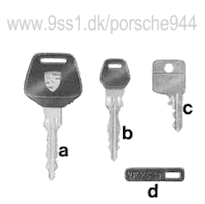 |
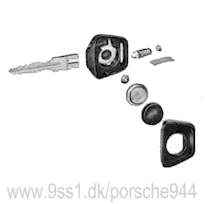 |
||||||||
| Always remove the ignition key, especially if children are left unattended in the vehicle. Unsupervised use of any vehicle key may cause serious personal injury. NEVER leave your vehicle unattended with the key in the ignition lock. Take the key and lock the doors. |
Keys The vehicle is supplied with three keys fitting all locks. All keys are symmetrical so that there is no wrong way of inserting them in the locks. Two keys (a) are fitted with a battery light which is integrated in the plastic handle and lights up upon pressing the contact button. The third key (b) is flat and should be kept as an "emergency key", for instance, in your purse. After pulling the plastic head off the flat key, you can snap on a luminous plastic handle available from your Porsche dealer. |
WARNING NEVER remove the key from the steering lock while you are driving or as the car is rolling to a stop. The steering column will lock when you remove the key, and you will not be able to steer the car. When the key bulb becomes weak, you should install a new battery of the same voltage. Acid leaking from a discharged battery might damage your clothing.
|
||||||||
| 10 | ||||||||||
|
Key number The key number is impressed on a plastic tag (d) which comes with the keys. Detach this tag and keep it in a safe place. The key numbers of the other keys are embossed on the key heads. For your protection against theft:
In case of loss, duplicate keys cannot be furnished by your Porsche dealer. Do not leave these keys in the vehicle. Keep them in a safe place. See "Lockable wheel nuts" for details. |
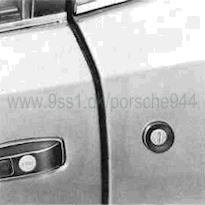 |
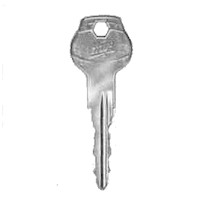 |
||||||
| Anti-theft alarm If your Porsche is equipped with an antitheft alarm system, you will be given an additional set of duplicate keys. Keep one of these keys in a safe place but not in the car. The alarm system can be activated or deactivated with this key only. The lock for the anti-theft alarm system is located behind the door lock on the driver's side. To activate the alarm system, insert the key and turn the lock slot 90° to the right. To deactivate the alarm system, insert the key and turn the lock slot 90° to the left. |
When the alarm system is activated, and an attempt is made to open either door, or to lift the engine hood or the rear hatch, the alarm will be triggered and will produce an intermittent high-pitched noise for about 30 seconds. Should an attempt be made to start the engine, the alarm will also be set off. However, when the alarm system is activated, it is impossible to start the engine. |
|||||||
| 11 | ||||||||
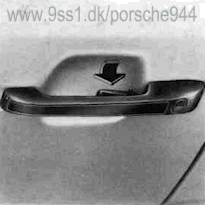 |
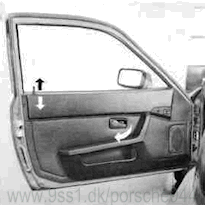 |
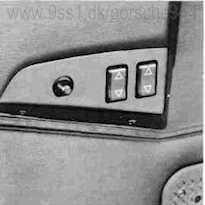 |
||||||||||||||||||
| Doors To lock, unlock and open doors from the outside
|
To lock, unlock and open doors from the inside
Power Windows To open or close windows, depress the rocker switches located in the door panels. The door window on the passenger's side can also be operated from the drivers side. The power windows are operational when the ignition switch is turned to positions 1 or 2. Information regarding ignition switch posi- |
tions will be found in section titled, "Ignition/starter switch with steering lock". When the ignition is turned off or the ignition key removed, the power windows can be operated until one door is opened. WARNING
|
||||||||||||||||||
| 12 | ||||||||||||||||||||
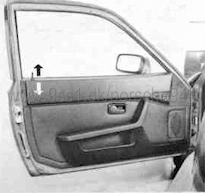 |
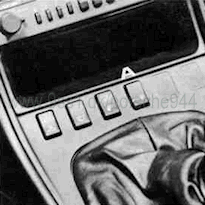 |
|||
| Central Locking By means of the central locking system both doors are electrically locked or unlocked (locking button lowered or raised) when a door lock is turned with the key. Before locking, make sure that both doors are properly closed. When the doors are locked, the removable roof is also locked at the same time. If the roof is open, it is not affected by the central locking system. Both doors can be individually locked from inside by pressing the locking button. If the locking button is used to unlock one door, the second door is also automatically unlocked. |
To prevent you from locking yourself out of the vehicle, it is not possible with the driver's door open to lock the door lock with the locking button. Emergency operation Should the central locking fail, both doors can be opened and closed mechanically. |
Central Locking Switch By pressing the central locking switch (A) in the centre console it is possible with the ignition key in position 2 to lock or unlock both doors electrically. As a check, if the doors are locked, a red indicator lamp in the switch lights up. If one of the doors has been locked manually, the red indicator lamp lights up. By pressing the switch, the door is unlocked; when pressed again, both doors are locked. With the ignition key removed, locking is possible by means of the central locking switch. To unlock, the ignition must be switched on or the locking button raised. |
||
| 13 | ||||
| Front seats The correct seating position is all-important for safe and fatigue-free driving. In order to satisfy individual requirements, the seat has infinitely variable adjustment. The rocker switches for the height adjustment are located at the outboard side of the seat. We recommend the following procedure for finding the correct position for the driver's seat:
|
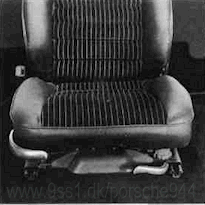 |
|||||||||||
| Seat Adjustment The seats permit individual longitudinal adjustment. After pulling up the locking lever on the outboard side of the seat, the seat can be repositioned forward or rearward. WARNING Do not adjust seats while the vehicle is in motion. The seat may move unexpectedly which could cause sudden loss of vehicle control or personal injury. |
Backrest Adjustment The backrests can be adjusted forward or rearward by pulling up the locking lever on the inboard side of the seat. WARNING Front seat passengers should not ride in a moving vehicle with the backrest reclined. Safety belts only offer protection when the backrest is upright and the belts are properly positioned on the body. Improperly positioned safety belts can cause serious personal injury in an accident. |
|||||||||||
| 14 | ||||||||||||
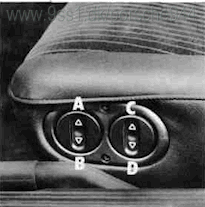 |
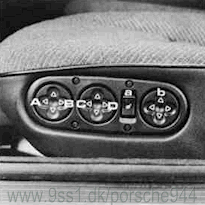 |
|||||||||
| Electric Seat Adjustment The lifting controls are designed for front and rear vertical adjustment by pressing a rocker switch. A Front end up B Front end down C Rear end up D Rear end down |
Vehicles with electric backrests and fore-and-aft adjustment are equipped with rocker switches with two additional functions. A Move seat forward B Move seat rearward C Move backrest forward D Move backrest rearward
|
Lumbar Support The lumbar support is controlled by the rear rocker switch (b) and can be extended/retracted or raised/lowered to any position to support the spine.
|
||||||||
| 15 | ||||||||||
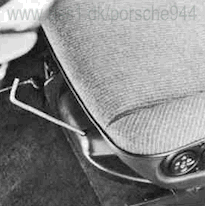 |
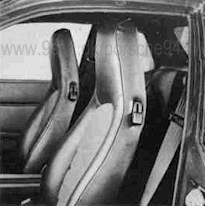 |
|||
| Emergency Adjustment In the event of a failure of the electrically operated seat adjuster, fore-and-aft adjustment of the seat can be obtained using the Allan key contained in the tool kit. The seat is adjusted by turning the servo motor located at the front on the seat using the Allan key. |
Backrest Lock The backrest is locked to prevent it from tilting forward when you are forced to brake hard. For unlocking, pull up the knob on the left or right side of the backrest. WARNING For driver and passenger protection, back-rest locks must be engaged at all times while the vehicle is in motion. |
|||
| 16 | ||||
| Safety Belts WARNING
|
|
|
||||||||||||||||||||||||||||||||||||||||||||||
| 17 | ||||||||||||||||||||||||||||||||||||||||||||||||
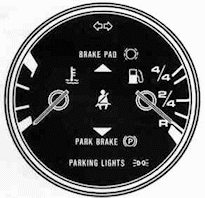 |
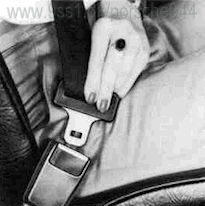 |
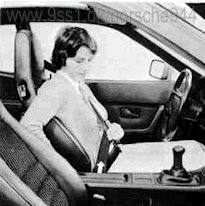 |
||||||||||
| Safety belt warning system An audio-visual warning system is interconnected with the driver's safety belt. Every time the ignition is turned on, the seat belt warning light in the left instrument cluster comes on for about 6 seconds to remind driver and passenger to buckle up. If the driver does not fasten the safety belt, the buzzer will continue for the duration of this six second period. The buzzer will go off as soon as the driver has buckled up. |
Inertia reel retractor The combination lap/shoulder belt with inertia reel locking mechanism adjusts automatically to your size and movements as long as the pull on the belt is slow. Rapid deceleration during hard braking or a collision locks the belt. The belt will also lock when you drive up or down a steep hill or in a sharp curve. Otherwise the shoulder belt will not inhibit your upper body movement. |
|
||||||||||
| 18 | ||||||||||||
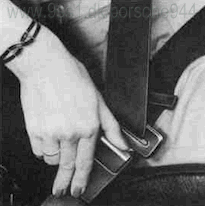 |
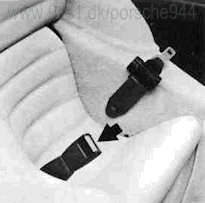 |
|||||||||||||||
|
Lap belts for rear seats The lap belt with inertia reel locking mechanism adjusts automatically to your size and movements as long as the pull on the belt is slow. Rapid deceleration during hard braking or a collision locks the belt. The belt will also lock when you drive up or down a steep hill or in a sharp curve.
|
|
||||||||||||||
| 19 | ||||||||||||||||
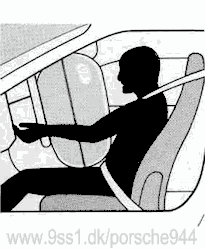 |
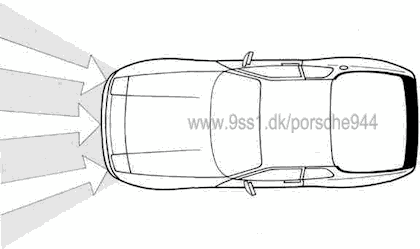 |
|||||||||
| Air Bag System The "Air Bag" in combination with the safety belt makes up a passive safety system which offers the driver and front seat passenger the greatest known protection from injuries in case of accident. The air bag system is composed of the following 3 major groups:
|
tion mechanism. In the ignition process, a solid propellant in the gas generator is combusted in a fraction of a second. This combustion generates the gas quantity and pressure necessary to fill the air bag. The air bag is located behind the steering wheel center pad on the driver's side, and on the passenger side behind the padding above the glove compartment. Due to the rapid deflation of the air bag after use, there is little danger of obstructed vision. Likewise, the noise of the inflation of the air bag generally goes unnoticed because of the collision noise. The air bag protects the face and upper body, and at the same time dampens the forward motion of the driver and passenger. |
Range of Effectiveness Even if your vehicle is equipped with an air bag, the safety belt must be worn, since the air bag system is only actuated by frontal collisions and at speeds of more than 13 to 19 mph (depending on collision angle). See figure for range of effectiveness. Below the actuation threshold of the air bag system, and during types of collisions which do not cause the actuation of the system, the seat belts provide the primary protection to the occupants when correctly worn. Therefore, all persons within the vehicle should always wear safety belts (in many states, state law requires the use of safety belts). See also the chapter "Safety Belts". |
||||||||
| 20 | ||||||||||
| Maintenance / Monitor Lights The air bag system monitors the operational readiness of the igniter, sensors, warning lamp, and control electronics itself. Any malfunctions which may arise are announced by the monitor lights in the right instrument cluster. Upon activation of the vehicle ignition circuit, the "Air Bag" notation in the instrument cluster lights up for approximately 5 seconds and then goes out again, indicating system readiness. In the following cases you should immediately consult an authorized Porsche dealer in order to assure the air bag system is functioning properly:
WARNING
|
If you sell your Porsche, notify the purchaser that the vehicle is equipped with an air bag, and refer him or her to the chapter, "Air Bag System", in the owner's manual (safety and disposal rules). Further information on the air bag system can be found on stickers in the glove compartment, at the interior light, as well as on all air bag components. |
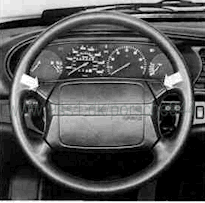 Horn Button In vehicles equipped with an AIR BAG, the horn buttons are mounted in the two upper spokes of the steering wheel (arrow). |
||||||||||||||||
| 21 | ||||||||||||||||||
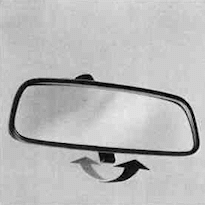 |
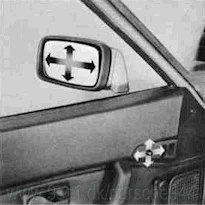 |
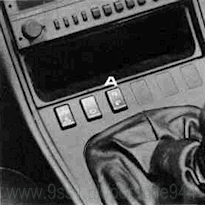 |
||
| Rear View Mirrors Do not put decals or other signs on the windows that may interfere with the driver's vision. Adjust the outside and inside mirrors before driving. It is important for safe driving that you have good vision to the rear. Inside day-night mirror You can adjust the day-night mirror from clear daylight visibility to non-glare visibility at night by moving the lever at the bottom of the mirror forward or rearward. |
Heated outside mirrors with remote control When you turn on the rear window defogger, the outside rear view mirror is also heated. The outside mirrors are adjustable from inside of the vehicle by a four direction switch located on the left door and a rocker switch located on the center console ahead of the gear selection lever. The rocker switch (A) selects either the left or right mirror for adjustment. Push the rocker switch forward to select the left mirror, and rearward to select the right mirror. Then the four direction switch will adjust the selected mirror in any of the four directions. |
The mirror housing is hinged and can be folded flat against the car in either direction to prevent damage in tight parking spots. If necessary, the outside mirrors can also be adjusted manually. |
||
| 22 | ||||
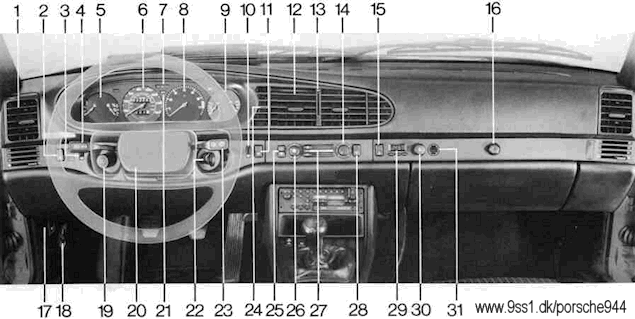 |
||||||||||||||||||||||||||||||||||||||||||||||||||||||||||||||||||
|
|
|
||||||||||||||||||||||||||||||||||||||||||||||||||||||||||||||||
| 23 | ||||||||||||||||||||||||||||||||||||||||||||||||||||||||||||||||||
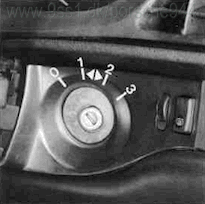 Ignition/Starter Switch with Steering Lock The steering is equipped with an anti-theft ignition lock. Switch positions
|
To conserve battery power, switch off other electrical consumers while playing radio in position "1".
The starter should not be operated for more than 10 to 15 seconds at a time. If the engine does not start the first time or stalls at any time, the ignition key must be returned to the "0" position. The non-repeat lock in the switch prevents the starter from being operated when the engine is running and guards against starter damage. |
To remove the key and to lock the steering wheel, turn the key back to position "0" and pull out. Turn the steering wheel until it locks. WARNING Never remove key from ignition lock or turn key off while vehicle is moving. The steering wheel will lock, causing loss of control. Instrument panel lights Warning lights for alternator, oil pressure, and brake system will light up for a bulb check when the ignition is turned on. They should go out after the engine is started. The brake warning light will go out after the parking brake has been fully released. See "Warning lights" for more details. Buzzer If you leave the key in the ignition/steering lock, the buzzer will sound when the driver's door is opened. This is a reminder to remove the key. For further details see "Starting Procedures" on the following page. |
||||||||||
| 24 | ||||||||||||
| Starting Procedures |
||||||||||||||||||
WARNING
Automatic Transmission - Start with selec- tor lever in Park. Manual Transmission - Start with gearshift lever in Neutral. Temperature sensors on the engine auto- |
matically provide the correct fuel/air mixture required for starting. Therefore, do not depress the accelerator pedal while starting a cold or a warm engine. When starting at very low outside temperatures, fully depress the clutch pedal, so that the starter only has to crank the engine. As soon as the engine starts, release the ignition key. If the engine fails to start after 10 to 15 seconds of cranking, wait about 10 seconds before engaging starter again. Do not let engine idle to warm it up. After starting, drive vehicle at moderate speeds and with gradual accelerations. Avoid high rpm and full throttle operation until the engine has reached normal operating temperature. Stopping engine Do not stop engine immediately after hard or extended driving. Keep engine running at increased idle for about two minutes to prevent excessive heat buildup before turning off engine. |
WARNING
If you have an automatic garage door... The transistorized ignition system in your Porsche may interfere with your electronically operated garage door. To check this: drive your Porsche close to the garage door and run the engine at different speeds. If the garage door opens or closes without your operating the garage door unit in your car, contact the dealer who installed the automatic garage door to have the frequency and/or coding of the garage door signal modified. |
||||||||||||||||
| 25 | ||||||||||||||||||
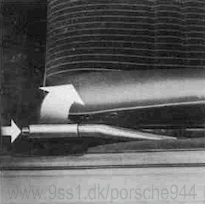 |
The brake warning light on the dashboard will go out after the engine is started and the parking brake is fully released. WARNING
|
WARNING Failure of one brake circuit will impair the braking capability resulting in an increased stopping distance. If one brake circuit has failed, the other will still operate. However, you will notice an increased pedal travel when you step on the brake. Should you encounter such experience, bring your vehicle safely to a full stop. Avoid driving the vehicle and instead have it towed to the nearest authorized Porsche dealer. Brake Pedal |
||||||||||||||
|
Parking Brake Lever Parking brake force is mechanically trans-ferred to the rear wheels by means of cables. Use the parking brake only after the vehicle has come to a full stop. To set parking brake,
|
Brakes Functioning of brake system Your Porsche is equipped with a power assisted hydraulic dual circuit brake system with disc brakes at the front and at the rear. Both circuits function independently. One brake circuit operates the front and the other the rear axle. In the unlikely event of hydraulic failure of one circuit, push the brake pedal down firmly and hold it in that position. A mechanical linkage activates the second circuit, and you will be able to bring the vehicle to a stop. |
WARNING
|
||||||||||||||
| 26 | ||||||||||||||||
Brake operation and brake warning light Make it a habit to check the operation of your brakes before driving. The failure of a brake circuit is indicated by the lighting up of the dual-circuit brake indicator lamp. See also brake fluid warning lamp. With correctly adjusted brakes the pedal travel to the point of brake actuation should be 13/16" to 19/16" (30 to 40 mm). Whenever the brake pedal travel is greater, have the brake system checked. Keep in mind that the braking distance increases very rapidly as the speed increases. At 60 mph/100 km/h, for example, it is not twice but four times longer than at 30 mph/ 50 km/h. Tire traction is also less effective when the roads are wet and slippery. Therefore, keep a safe distance from the car in front of you. |
Brake Booster The brake booster assists braking only when the engine is running. When the car is moving while the engine is not running, or if the brake booster is defective, more pressure on the brake pedal is required to bring the car to a halt. Moisture or road salt on brakes affects braking WARNING Driving through water may reduce tire traction. Moisture on brakes from road water, car wash, or coating of road salt may affect braking efficiency. Cautiously apply brakes to test them after being exposed to such conditions. When the vehicle is driven on salted roads for extended periods, the brakes should be hosed down thoroughly about every 2 weeks. An automatic car-wash facility cannot do this job properly. Brakes will dry after a few cautious brake applications. Brake wear Our automobiles have excellent brakes, but they are still subject to wear, depending on how the brakes are used. Have the brake system inspected at the intervals recommended in your Warranty & Maintenance booklet. |
New brake pads or linings
Brake pads or linings may not have the highest possible braking efficiency when new. Therefore allow for longer braking distance during the initial 100 to 150 miles or 150 to 250 kilometers of normal city driving; longer if fewer stops are realized. Clutch Pedal Due to the hydraulic operation of the clutch, pedal play should be 0.1" or 2.5 mm. To check the play, depress the clutch pedal. Excessive play or tightness indicate a malfunction of the clutch. Both conditions can lead to severe damage. Contact your Porsche dealer promptly to have the cause located and corrected. Always depress the clutch pedal fully when changing gears. Do not hold the car on a steep hill with the clutch pedal partially depressed. This will cause premature wear or damage. |
||||
| 27 | ||||||
|
ABS Brake System (Antilock brake system) The ABS system represents a major contribution to the enhancement of active safety in your vehicle. This system prevents the wheels from locking in a panic stop on almost all road surfaces. With ABS system in your vehicle, the following areas are enhanced: Full steerability, vehicle remains steerable under all braking forces. Good directional control, no swerving caused by locking of wheels under braking conditions. Excellent stopping distance, stopping distances are usually reduced because controlled braking is maximized. Prevention of wheel lock up, no brake-induced sliding and thus no localized tire wear from emergency braking. The crucial advantage of ABS system over a conventional brake system is in the area of maintaining directional control and maneuverability of the car in emergency situations, including panic braking in turns. WARNING: In spite of the improved handling afforded by the ABS system, it still remains the responsibility of the driver to adapt the driving style to the prevailing road and weather conditions, as well as, obeying traffic laws. In no case, should the higher degree of safety offered by ABS be regarded as a |
justification for taking greater risks. Other vehicles not equipped with the ABS system may not be able to maintain control, especially on wet or poor road surfaces and thus may be more likely to impact you in the rear. To minimize that risk, use your ABS system to increase your ability to maneuver to avoid dangerous situations and not merely to try to stop in the shortest distance possible. Driving with the ABS System A wheel speed sensor is fitted to each of the four wheels. If wheel slippage of either of the front wheels or the rear wheels is sensed during braking, the brake pressure is adjusted automatically until the wheel no longer slips. The brake pressure is regulated for each front wheel individually and for both rear wheels together. On a road surface which is slippery on only one side, the rear wheel which is braking on the slippery surface determines the brake pressure which will be applied equally to both rear wheels. This ensures that directional stability is maintained. However, if braking force approaches the wheel locking-up point for all wheels (panic braking) the ABS system will intervene in a way comparable with rapid rhythmic braking. The proper operation of ABS is perceived by the driver as a pulsating brake pedal in conjunction with audible noise and perhaps some vibration. The driver is thereby warned to reduce vehicle speed appropriate for the prevailing road conditions. |
If your ABS system should ever malfunction, the ABS system is automatically switched off, but the normal brake system, without ABS, would remain fully operational. Such a malfunction would be indicated by the illumination of the central warning light, as well as the "ANTILOCK" light on the right hand side of the instrument cluster. If the ABS system becomes inoperative, take your vehicle to your authorized dealer immediately. Note The control unit of the ABS brake system is set for standard tire sizes. If non-standard tires are fitted, the control unit may misinterpret the speed of the vehicle, because of the variant data it receives from the sensors on the axles. If the difference in rolling radius exceeds approx. 17%, the control unit deactivates the ABS system and the ABS warning lamp lights up. |
||
| 28 | ||||
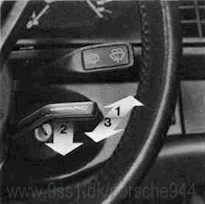 1 Set accelerate 2 Reset 3 Cancel Automatic Speed Control The automatic speed control allows you to maintain a constant cruising speed of 25 mph (40 km/h) or higher, without actuating the accelerator pedal. Any manual operation, such as accelerating, gearshifting or braking can be done independent of the automatic speed control. The spring loaded control lever operating the automatic speed control is located just below the wiper/ washer lever. While driving with the automatic speed control set at speeds above 25 mph (40 km/ h), do not bring shift lever into the Neutral position as excessive engine rpm will result. |
To operate the automatic speed control Accelerate to the desired cruising speed, push lever toward instrument cluster (arrow 1) and release. This sets the cruising speed and stores it in a memory. After a second or two, automatic speed control will take over and you can remove your foot from the accelerator pedal. The set cruising speed will be maintained automatically. WARNING Do not use the cruise control when it may be unsafe to keep the car at a constant speed. For example, a constant speed may not be safe in heavy traffic, or on winding or slippery roads. With the cruise control system engaged, the engine speed will not return to idle when removing the foot from the accelerator pedal. Please observe all local and national speed limits. Passing: If you want to drive faster for a brief moment, for example when passing another vehicle, actuate the accelerator. When you take your foot off the accelerator pedal, the preset speed will automatically be resumed. Gearshifting: When shifting gears, the automatic speed control is only disengaged as long as the clutch pedal is depressed. The preset speed will be resumed as soon as you take your foot off the clutch pedal. Braking and stopping: Whenever you apply the brake or come to a stop, the automatic speed control is disengaged. Move the lever down (arrow 2), and the preset speed will be resumed. |
Switching system off: To switch off the automatic speed control, move the lever toward you (arrow 3). To resume the preset speed, move the lever down (arrow 2). To change the preset cruising speed Increase preset speed: Accelerate by depressing the accelerator pedal. When the desired speed is reached push lever toward instrument cluster (arrow 1) and take your foot off the accelerator pedal. Now the new cruising speed is set and stored in the memory. As an alternative, you can hold the lever in the front position (arrow 1), without depressing the accelerator pedal. The car will accelerate on its own. When the desired speed is reached, release the lever. Decrease preset speed: Apply the brake, which will disengage the automatic speed control. When the vehicle has slowed down to the desired speed, push lever toward instrument cluster (arrow 1) to set the new cruising speed. As an alternative, disengage the automatic speed control by moving the lever toward you (arrow 3). When the vehicle has slowed down to the desired speed, push lever toward instrument cluster (arrow 1) to register the new cruising speed in the memory. Note: When driving up a hill, if the engine power is insufficient in a particular gear, the speed control will be disengaged automatically. Shift to a lower gear to avoid stalling the engine. |
||
| 29 | ||||
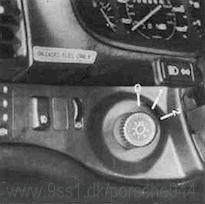 |
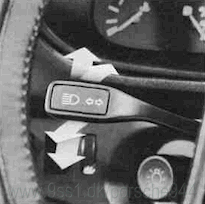 |
Lane changer To indicate your intention when changing lanes on the highway, slightly push the turn signal switch lever up or down to the point of resistance. The lever will return to the OFF position when released. Headlight dimmer With the light switch at stage 2, high beam is switched on by pressing the lever towards the instrument panel, and low beam is switched on by pulling the lever towards the steering wheel. When high beams are on, the blue indicator light between the tachometer and the right instrument cluster will light up. You can flash signal other motorists by repeatedly pulling and releasing the lever just up to the point of resistance. |
||||
| Light Switch Parking light - 1st position Headlights -2nd position (with ignition key in switch position "1"). Tail lights, side marker lights, license plate and instrument lights are on in both switch positions. The retractable headlights open when turning the switch to the second position. When you open the door while the lights are on, the buzzer will sound. It is your reminder to switch off the lights. Instrument illumination The instrument illumination goes on when the vehicle lights are turned on. Turn the |
knob to the left of the light switch for infinitely variable brightness control. Turn Signal/Headlight Dimmer Switch Lever (ignition on) Lever up - right turn signal Lever down - left turn signal The turn signal lever turns off automatically when the steering wheel is straightened out after completing a turn. If a turn signal fails, the indicator light flashes about twice as fast. The light bulb may have to be replaced. |
Headlight flasher During daylight, you can flash signal with your foglights (in lieu of horn) by repeatedly pulling and releasing the lever just up to the point of resistance.
Parking lights - with ignition off . ... Lever up - right side parking lights on Lever down - left side parking lights on |
||||
| 30 | ||||||
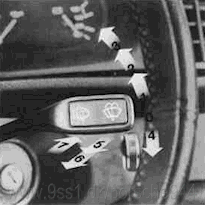 Windshield Wiper/Washer Lever (with intermittent wiper operation) The windshield wiper/washer switch has se-ven positions: 1 - Low speed 2 - Normal speed 3 - High speed 4 - Intermittent wiper operation 5 - Windshield washers 6 - Windshield washers and wipers 7 - Headlight washers The time intervals can be set at the control element to the right of the ignition lock. |
Pulling the lever from its basic position towards the steering wheel activates the windshield washer pump in the first stage (switch position 5) and the windshield wipers in the second stage (switch position 6). The electric windshield washer system can be operated by pulling the lever toward the steering wheel from any wiper position. When the ignition is switched on, the washer nozzles are heated, depending on the outdoor temperature. Nevertheless, a commercial windshield anti-freeze solution should be added to the windshield washer water during cold weather conditions. Avoid running the wiper blades over a dry windshield to prevent scratching the glass. Spray on washer fluid first. A scratched windshield will reduce visibility. Always loosen blades frozen to glass before operating wipers to prevent damage to wiper motor. WARNING Worn or dirty wiper blades will reduce visibility, making driving hazardous. Clean blades regularly to remove road film and carwash wax buildup. Use an alcohol base cleaning solution, a lint free cloth and wipe lengthwise. Clean all inside and outside window glass regularly. In vehicles without Securiflex windshields use an alcohol base cleaning solution and wipe dry with a lint free or a chamois cloth. |
In vehicles with Sekuriflex windshields, the plastic coating on the inside of the windshield must not have gummed labels put on it or be cleaned using aggressive agents or dry methods. If very dirty, it can be cleaned with benzine. Make certain that the plastic coating is not damaged in cleaning by hard objects such as jewelry or wristwatches.
|
||
| 31 | ||||
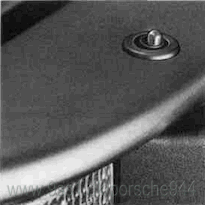 944 / 944 S |
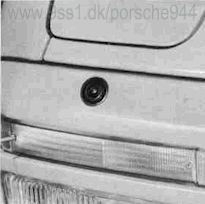 944 Turbo |
|||||
A separate pump supplies high-pressure water to the spray nozzles located in front of the headlights on the bumper. The high pressure stream soaks the dirt on the lenses and washes it off. Repeat the wash cycle as necessary to remove heavy dirt accumulation. |
Since the system uses a lot of water, a reservoir holding approx. 1,6 U.S. gals, or 6 liters has been installed in the engine compartment. This reservoir also supplies the windshield washer with water. Use windshield washer solvent with anti-freeze all year round, so that both washer systems also function at freezing temperatures. Do not use engine coolant anti-freeze or any other solution that may damage the car paint. |
|||||
| 32 | ||||||
| Instruments: Gauges Warning Lights Indicator Lights |
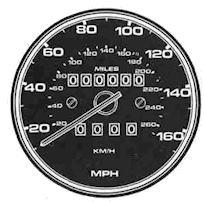 944 / 944 S |
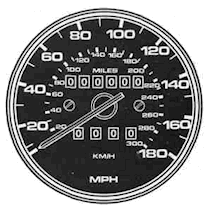 944 Turbo |
||
| Speedometer The speedometer indicates driving speed per hour. In USA: Miles per hour and Kilometers per hour In Canada: Kilometers per hour The upper odometer records total distance driven and cannot be turned back. |
||||
| 33 | ||||
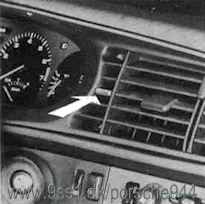 |
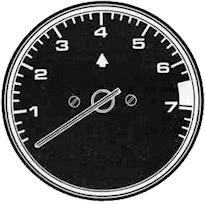 944 / 944 S |
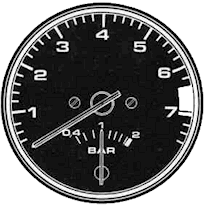 944 Turbo |
||
| The trip odometer in the lower part of the speedometer can be turned back to zero by pressing the reset-button, located in the left section of the center dashboard vent. The ignition must be on. | Tachometer The transistorized tachometer operates on the pulse count principle and shows engine speed in revolutions per minute (rpm). The mark at the end of the scale indicates the maximum permissible engine rpm. Before reaching this area, the next higher gear should be selected. Earlier shifting saves fuel. Shift to the next lower gear when the engine rpm drops below 1500 rpm. The speed limiting governor prevents the engine from being overrevved under load. |
Boost Pressure Gauge On the 944 Turbo there is a boost pressure gauge in the lower part of the tachometer. This instrument indicates the pressure in the intake manifold. With the ignition on and the engine stopped, the indicated pressure corresponds to the ambient air pressure (atmospheric pressure) of approx. 1 bar. Should an excessively high boost pressure occur as a result of a defect, the fuel supply or the ignition is cut off automatically. |
||
| 34 | ||||
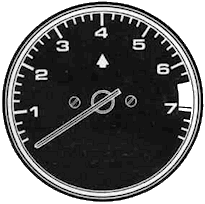 944 / 944 S |
Computer Assisted Shift Indicator System (Manual Transmission only) A computer continually evaluates vehicle data, such as driving speed, engine rpm, engine load and engine temperature. When the CASIS arrow in the tachometer lights up, it means the engine could operate more economically. The light indicates that you can increase fuel efficiency by shifting into a higher gear. The CASIS light will go out when a higher gear has been engaged, when taking your foot off the accelerator pedal or when accelerating at a higher rate. In fifth gear the CASIS light is inoperative. During maximum acceleration, the CASIS arrow light will only light up at a point where engine rpm is such that improved acceleration can be obtained by shifting into the next higher gear. This means the CASIS arrow does not indicate any set shift point, but that the computer calculated shift points will depend on the way you drive. The arrow will light up at the lowest speed range when cruising, and at the highest speed range when accelerating with wide open throttle. |
How to use CASIS Drive your Porsche shifting as you normally would. As soon as the engine reaches uneconomical load range, the CASIS light will remind you to shift into the next higher gear to keep the engine at the same performance level but with lower fuel consumption. You will get used to CASIS quickly and there fore operate your Porsche with the CASIS arrow light coming on only now and then. WARNING Use CASIS to your best advantage but remember that traffic, road and weather conditions must always have priority when shifting gears or changing speeds. |
||||
| 35 | ||||||
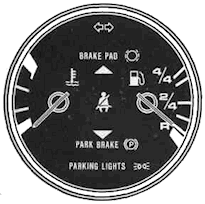 Left Instrument Cluster The left instrument cluster includes the coolant temperature and fuel gauges as well as warning lights for coolant temperature, fuel reserve, brake-lining wear, safety belt, parking light and parking brake. The two arrows at the top are turn signal indicators for vehicles with trailer coupling.
Indicator Needle in lower field - engine is cold Avoid high speeds and high engine rpm. During cold engine operation, engine response and power levels will vary from that |
of a warm engine. Due caution and notice of these engine characteristics will ensure safe operation of the vehicle. Needle in center field - normal Under normal driving conditions, needle should remain in center field. The needle may reach the upper field, especially at high engine loads, but should return to "normal" when engine load is reduced. Needle in upper field - warning If needle enters the upper field the engine is overheating the warning light comes on. Reduce speed and engine rpm. The needle should return to the center field and the indicator light goes out. If the needle does not return to the center field, and the indicator light does not go out, the radiator fan may not be working to provide sufficient engine cooling. Pull off the road and turn off the engine. The fan should still be running for a while. Failure to do so may result in severe damage to the engine. WARNING
|
If the fan is not working, the fuse for the fan may be burned out, or the relay may be defective. See "Fuses and Relays". After the engine has cooled down, check the coolant level (see "Cooling System"). If the coolant level is low, top it up with water. Check for possible leaks. If the coolant level is normal, proceed to the nearest workshop. Avoid idle speed and stop-and-go driving. But with an inoperative fan, the coolant will heat up again. When the needle enters the upper field, stop again and let the engine cool down before you continue driving. Coolant system malfunctions should be remedied by the nearest Porsche dealer, as severe engine damage may occur. |
||||||||||||
| 36 | ||||||||||||||
If the needle enters the area in the bottom and the fuel reserve indicator lights up, there is only a reserve of about. 2.1 U.S. gal/8 liters left in the tank. Time to refuel at the next gas station.
If the light stays on when the engine is running or comes on while driving, the brake pads are worn, excessively. Do not continue to operate the vehicle but have your Porsche dealer check and replace the brake pads.
When the ignition is turned on the light will come on for about 6 seconds to remind driver and passenger to buckle up. See "Safety Belts" for more details. |
Parking Light The parking light indicator at the bottom in the left instrument cluster lights up when the parking lights are switched on.
|
Central Warning Light The central warning light comes on after turning on the ignition. This light monitors all functions displayed by the instruments. If one of these functions fails, the central warning light and the pertinent indicator light come on until the malfunction has been corrected. The vehicle should immediately be taken to the nearest authorized workshop. |
||||||||||||||
| 37 | ||||||||||||||||
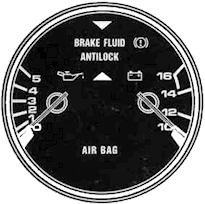 Right Instrument Cluster The right instrument cluster combines the oil pressure gauge with the oil pressure warning light, the voltmeter with the alternator warning light as well as the brake fluid warning light. |
At 5.000 rpm, with the engine at normal operating temperature (approx. 90°C / 194°F), the pressure should be approx. 4 bar. A slight drop in oil pressure is normal under certain operating conditions such as prolonged highway driving in hot weather. At idle speed, with the engine oil hot, the oil pressure can sink to 0.5 bar - this does not indicate any loss of engine performance. However, if the oil pressure drops suddenly while you are driving, or if the warning light comes on, pull off the road, stop the engine and wait for it to cool down. Check the engine oil level. If the oil level is normal, contact the nearest dealer. Oil Pressure Warning Light The oil pressure warning light comes on when the ignition is turned on. It should go out when the engine is started and has reached the correct oil pressure. If the oil pressure warning light does not light up when turning the ignition on, or if it does not go out after starting the engine, contact your Porsche dealer immediately. If the oil pressure warning light comes on while you are driving, pull off the road and stop the engine. Check the oil level to make sure you have enough oil. If oil level is correct and the oil |
pressure warning light is still on, do not drive the vehicle as severe engine damage may result. Contact your nearest Porsche dealer for assistance. An occasional brief flickering of the oil pressure warning light at idle speed and normal engine temperature is no cause for concern if the light goes out upon acceleration. The oil pressure warning light is not an indicator for low engine oil level. To check the oil level, always use the dipstick. Make it a habit to have the oil level checked with every fuel filling.
|
||||||
| 38 | ||||||||
| Alternator Warning Light The alternator warning light comes on when the ignition is turned on. It should go out after the engine is started. If the alternator warning light does not light up when turning the ignition on, or if it does not go out after starting the engine, there is a malfunction in the electrical system. If this is the case, contact your Porsche dealer. WARNING If the alternator warning light comes on while you are driving, pull off the road and stop the engine. Check whether the Polyrib-belt is slipping or broken. The Polyrib-belt not only drives the alternator for battery charging, but also the air conditioner compressor. If the light just flickers lightly, the Polyrib belt may be loose and is slipping. The belt should be tightened or replaced before you continue driving. |
Light The brake warning light monitors the hydraulic dual-circuit brake system. It lights up when the ignition is turned on and should go out after the engine has been started. If the brake warning light fails to light up when the ignition is turned on, or if it fails to go out after the engine is started, there may be a malfunction in the electrical system. Let your Porsche dealer locate and correct the condition promptly. Should the light come on while driving, the brake fluid level in the reservoir could be too low, or one of the dual brake circuits may have failed. In either case, the brakes will function but a much longer distance and a far greater pedal pressure are required to bring the car to a halt. See "Brakes" for more details. Carefully pull off the road and stop. Have your car towed to the nearest dealer for repair. Continued operation of a car with defective brakes is dangerous. |
Antilock The warning light goes on in the event of a malfunction in the ABS system. The system is switched off; the normal brake system remains fully operational. If the light comes on, take your vehicle to your authorized dealer for service immediately. Air Bag See "Air Bag System" for details. |
||||
| 39 | ||||||
|
Clock Time setting A. 12 AM, PM or 24.00 h With the clock in the time readout mode, keep button (2) depressed for 4 seconds -12 AM, PM or 24.00 flashing. After pushing button (1), either a 12-hour (AM + PM) or a 24-hour setting program can be selected. If you only want to change the display mode, push button (3). The clock then returns to its normal timekeeping function. B. Hours Push button (2) a second time - hour display flashes. Set hour by pushing button (1). After pushing button (3)*, the clock returns to the time readout mode with new hour setting. C. Minutes Push button (2) once more - minute display flashes. Set minute by pushing button (1). Upon pushing button (3)*, the clock is started - accurate to within 1 second. |
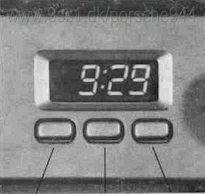
|
|||||||||||||
| If button (3) is pushed during operation A and B, the setting procedure must be restarted (push button (2)). |
Stop watch function The stop watch can only be set in motion if the clock is in its normal timekeeping mode and not during setting operations.
|
|||||||||||||
| 40 | ||||||||||||||
Do not damage the socket by trying to insert plugs of the wrong design. |
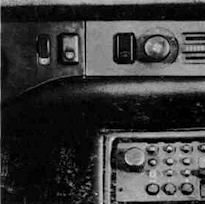 |
|||||||||||||||
The rear window defogger, together with the flow through ventilation, will help to keep the inside of the rear window clear of condensation and frost in the winter. Depress the switch to turn on the rear window defogger. The control light in the switch will light up to remind you that the defogger is switched on. After the rear window has been cleared, switch off the rear window defogger to avoid unnecessary drain on the battery. |
The emergency flasher works independently of the ignition switch position. WARNING
|
|
||||||||||||||
| 41 | ||||||||||||||||
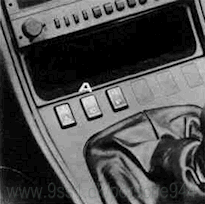 |
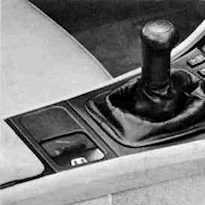 |
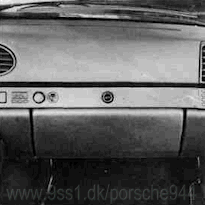 |
||||
|
Ashtray The ashtray is in the center console. To empty the tray, pull it out of its well. Reinsert it so that the light "window" points toward the bulb on the back inside the well. WARNING Never use ashtray as waste paper disposal. Fire hazard! |
Glove Compartment Press locking button to open glove compartment. With the car lights turned on, the glove compartment light is automatically switched on when the glove compartment is opened. The compartment is lockable with the ignition key to help prevent theft. WARNING Keep glove compartment door closed while driving to prevent injury during a collision. |
||||
| 42 | ||||||
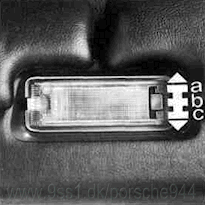 |
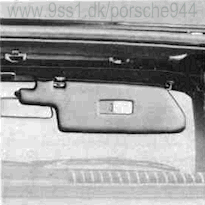 |
|||
| Overhead Interior Light Located between the two sun visors the interior light has a three position switch. Switch Positions Rearward (a) - on continuously Center (b) - off Foreward (c) - on, only with doors open |
Sun Visors To protect driver and passenger from side glare, the sun visors can be moved to the sides after lifting them out of their center mounting. The make-up mirror on the rear of the visor is fitted with a protective sliding shutter. |
|||
| 43 | ||||
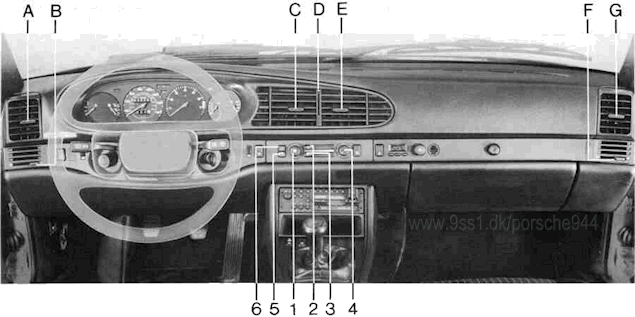 Heating Ventilation System |
||||||||||||
|
1 Fan switch 2 Air distribution to windshield 3 Air distribution to footwell outlets 4 Temperature switch 5 Defroster switch 6 Recirculation switch |
A Air outlet - left side dashboard vent B Open and close - left side dashboard vent
|
|
||||||||||
| 44a | ||||||||||||
|
Heating and Ventilation WARNING
Should you suspect that the air conditioner is damaged, have it checked promptly. Leaks must be sealed immediately, since loss of refrigerant may result in serious damage to the air conditioner system. |
The upper lever (2) controls the air flow to the windshield" right position: open, left position: closed. The lower lever (3) controls the air flow to the footwell outlets (right position: open -left position: closed). The center dashboard vent can be opened or closed by operating the lever (D). For closing, the lever is pushed all the way up. For opening, push the lever downward for the desired air volume. The direction of the air outlet is controlled by means of handles (C, E) on the vents. The side dashboard vents are opened or closed by means of the lower levers (B, F) ( Heater Control Activation of the heater control system ensures temperature control in the passenger compartment in accordance with the temperature range preset by the temperature knob. The passenger compartment temperature is kept constant under varying climatic conditions. |
|
||||||||||||||
| 44b | ||||||||||||||||
 |
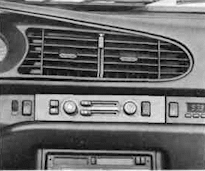 |
|||||
The air conditioning system works only when the engine is running. Its refrigerating capacity depends on engine speed. If a high refrigerating capacity is desired, it is necessary to rev up the engine - particularly in city or bumper-to-bumper traffic. The air conditioning system can be turned on at any air distribution position by pressing the air conditioner switch. When the system is turned on, the air conditioning compressor is activated via a magnetic clutch. Optimal cooling is achieved when the fan control switch is at position 4, the windows are closed and the lateral as well as the |
center dashboard vents are fully opened and the temperature switch is set at maximum cooling power. When the air conditioning system is on, additional cooled air enters the glove compartment through a vent. After prolonged exposure to sun, it is recommended that you ventilate the passenger compartment with the windows down and air conditioning on. Should the air conditioning system fail, i. e. uncooled air flows through the vents while the system is switched on, have it checked in an authorized workshop. |
|||||
| 45 | ||||||
| Functioning The automatic system controls the passenger compartment temperature in accordance with the temperature preset by the temperature knob. The passenger compartment temperature is kept constant under varying climatic conditions. Cold and warm air is automatically mixed by means of air flaps operated by a servo motor. The servo motor is controlled by a passenger compartment temperature sensor, an ambient temperature sensor and a temperature sensor located in the air conditioner. There are several options to satisfy the requirements of individual comfort with an automatically controlled air-conditioning system: The upper level (2) is operated to direct the air flow towards the windshield (right position: open; left position: closed). The lower level (3) can be used to direct the air flow to the footwell outlets (right position: open; left position: closed). The positions of these two levers are infinitely variable and can be set independently of one another. A higher or lower temperature range can be preselected by means of the temperature control knob. |
Air Conditioning System Maintenance The air conditioning system must be turned on for a short period of time at least once a month. This instruction should be observed particularly during the cold season to ensure proper lubrication of the sealing rings and compressor bearings. For this purpose, set the temperature control knob at maximum cooling temperature (extreme counterclockwise position). Check the compressor polyrib belt for proper tension during regular maintenance. Due to the loss of refrigerant, which is technically inevitable, the refrigerant level in the fluid reservoir should be checked at least once a year. If gas bubbles are visible over an extended period of time in the inspection window of the fluid reservoir while the air conditioner is running, there is a deficit of refrigerant in the air conditioning system. The brief appearance of gas bubbles is due to technical reasons. Should the air conditioning system fail, i. e. uncooled air flows through the vents while the system is switched on, have it checked by your Porsche dealer. |
|||
| 46 | ||||
|
Break-in Hints for the first 1.000 miles / 1.600 kilometers There are no specific break-in rules for your Porsche. However, by observing a few precautions you can help extend the service life and performance of your engine. During the first 1.000 miles / 1.600 km, all working components of the engine adjust to each other to a certain degree. Therefore: Avoid full throttle starts and abrupt stops. Change speeds frequently. Vary the throttle load. Do not exceed maximum engine speed of 5.000 rpm (revolutions per minute). Do not run a cold engine at high rpm or in Neutral. Do not let the engine labor, especially when driving uphill. Shift to the next proper gear in time (use the most favorable rpm range). There may be a slight stiffness in the steering, gearshifting or other controls during the break-in period, which will gradually disappear. Never lug the engine in high gear at low speeds. This rule applies all the time, not just during the break-in period. Breaking in brake pads Brake pads do not possess maximum braking efficiency when the car is new. Therefore more pedal force is necessary during the first 100 to 150 miles (150 to 250 km). This also applies to replacement brake pads. |
New tires New tires do not possess maximum traction. They tend to be slippery. Break in new tires by driving at moderate speeds during the first 60 to 120 miles (100 to 200 km), and longer braking distances must be anticipated. Engine Oil Consumption During the break-in period oil consumption may be higher than normal. As always, the rate of oil consumption depends on the quality and viscosity of oil, the speed at which the engine is operated, the climate, road conditions as well as the amount of dilution and oxidation of the lubricant. Check engine oil level, add if necessary. Make it a habit to have engine oil checked with every fuel filling. |
|||
| 47 | ||||
| Engine Exhaust WARNING
|
Operating Your Porsche in other Countries Government regulations in the United States and Canada require that automobiles meet specific emission regulations and safety standards. Therefore cars built for the U.S. and Canada differ from vehicles sold in other countries. If you plan to take your Porsche outside the continental limits of the United States or Canada, there is the possibility that
If you bought your car abroad and want to bring it back home, be sure to find out about shipping and forwarding requirements, as well as current import and customs regulations. |
|||||||||||||||||||||||
| 48 | ||||||||||||||||||||||||
| Fuel Economy Fuel economy will vary depending on where, when and how you drive, optional equipment installed, and the general condition of your car. A car tuned to specifications and correctly maintained, will help you get maximum fuel economy.
|
Please observe all local and national speed limits. |
|||||||||||||||||||||||||||||||||||||
| 49 | ||||||||||||||||||||||||||||||||||||||
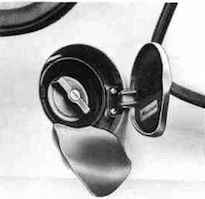 Fuel Filler Cap The lockable fuel filler cap is on the right side panel of the car. When putting the cap back on, twist it clockwise until it stops with an audible click. We recommend you turn off the engine when filling the fuel tank. Fuel tank capacity is listed under "Filling Capacities". If you lose your fuel filler cap, replace it immediately with a cap of the same design to reduce the possibility of a fire in a collision. |
Fuel Recommendation Your Porsche is equipped with a catalytic converter and must use UNLEADED FUEL ONLY. 944: Minimum octane rating is 91 RON (87 CLC or AKI rating on US fuel pumps). 944 S / 944 Turbo: Minimum octane rating is 95 RON (90 CLC or AKI rating on US fuel pumps). Federal law prohibits use of leaded fuel in this vehicle. The use of UNLEADED FUEL ONLY is critically important to the life of the catalytic converter. Deposits from leaded gasolines will ruin the converter and make it ineffective as an emission control device. Cars with a catalytic converter have a smaller fuel tank opening, and gas station pumps have smaller nozzles. This will prevent accidental pumping of leaded fuel into cars with a catalytic converter. Unleaded fuels may not be available outside the continental U.S. and Canada. Therefore, we recommend you do not take your car to areas or countries where unleaded fuel may not be available. Octane ratings Octane rating indicates a gasoline's ability to resist detonation. Therefore, buying the correct octane gas is important to prevent engine "knock" and possible engine damage. The 91 RON (95 RON) octane rating of your |
car is based on the research method. The CLC (U.S. Cost of Living Council octane rating) or AKI (antiknock index) usually displayed on U.S. gasoline pumps is calculated as research octane number plus motor octane number, divided by 2, that is written as: The CLC or AKI octane rating is usually lower than the RON rating: 91 RON equals ............ 87 CLC or AKI 95 RON equals ............ 90 CLC or AKI |
||
| 50 | ||||
WARNING
Do not use any fuel with octane ratings lower than 91 RON or 87 CLC or AKI, 944S/944 Turbo 95 RON or 90 CLC or AKI. Gasolines containing alcohol Gasoline containing alcohol is available at gas stations in some areas. The gas pump may not be labeled to identify that alcohol is present in the gasoline. If it is labeled, it may not identify what amount and type(s) of alcohol |
are used. We recommend you DO NOT use fuels where the alcohol content cannot be identified. Gasolines containing methanol DO NOT use fuels containing methanol (methyl alcohol, wood alcohol). The use of fuel containing this type of alcohol can result in vehicle drivability and performance problems and may damage critical parts of your vehicle's fuel and emission control systems. Gasolines containing ethanol A mixture of unleaded gasoline and ethanol (ethyl alcohol, grain alcohol) is sold in some areas. This mixture is sometimes called "Gasohol". You may use gasohol in your |
Porsche, provided it contains no more than 10% ethanol, and the octane requirements for your vehicle are met. However, we strongly recommend to switch back to gasoline without ethanol, if you experience any of the following problems with your vehicle:
|
||||||||||||
| 51 | ||||||||||||||
| Gearshifting Manual Transmission |
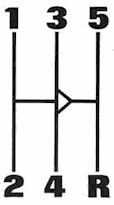 |
Maximum downshift points 5th to 4th gear 944 115 mph/1 80 km/h or 4300 rpm 944 S 123 mph/1 98 km/h or 5400 rpm Turbo 130 mph/210 km/h or 5000 rpm 4th to 3rd gear 944 85 mph/1 36 km/h or 4750 rpm 944 S 91 mph/1 46 km/h or 5000 rpm Turbo 96 mph/1 55 km/h or 4500 rpm 3rd to 2nd gear 944 58 mph/ 94 km/h or 4500 rpm 944 S 61 mph/ 98 km/h or 4600 rpm Turbo 65 mph/1 05 km/h or 4250 rpm 2nd to 1st gear 944 34 mph/ 55 km/h or 3850 rpm 944 S 36 mph/ 58 km/h or 4000 rpm Turbo 38 mph/ 62 km/h or 3700 rpm Minimum upshifting points 1st to 2nd gear at 15 mph/24 km/h or 944 2850 rpm 944 S 2800 rpm Turbo 2850 rpm 2nd to 3rd gear at 25 mph/40 km/h or 944 2800 rpm 944 S 2750 rpm Turbo 2400 rpm 3rd to 4th gear at 40 mph/64 km/h or 944 3050 rpm 944 S 3000 rpm Turbo 2750 rpm 4th to 5th gear at 48 mph/77 km/h or 944 2700 rpm 944 S 2650 rpm Turbo 2300 rpm |
||
| The Porsche transmission with servo-lock synchronization permits rapid and precise shifting of gears. But be sure when changing gears that the clutch pedal is fully depressed to the floor, and that the gearshift lever is completely engaged. The engine speeds for the individual gears are listed on this page. Reverse Only shift into reverse when the car has come to a complete stop. The clutch pedal must be depressed and the vehicle must be stationary before shifting into reverse; only then move the gearshift lever to the right (overcoming the spring resistance) and then to the rear. |
Both back-up lights come on when the transmission is put into reverse (with ignition on). For smooth shifting, observe the following shift points: The specified maximum rpm figures should not be exceeded when shifting down, as otherwise the engine speed would be too high. This applies to standard gear ratios only. Please observe all local and national speed limits! |
|||
| 52 | ||||
| Controls for Automatic Transmission The selector lever has 6 positions:
|
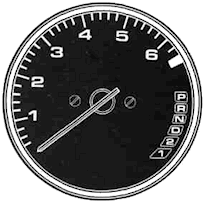 |
... If the selector lever is unintentionally moved into Neutral (N) while driving, take your foot off the accelerator pedal and wait until the engine speed has dropped to idle before selecting a driving position. Never shift into Reverse (R) or Park (P) when the car is in motion. ... Never get out of the driver's seat when the engine is running and the selector lever is not in the "P" position. Move the selector lever to "P" and apply parking brake. ... Always make sure the selector lever is in the "P" position when checking under the hood. Otherwise, any increase in engine speed may set the vehicle in motion, even with the parking brake applied. ... A driving position must never be used for holding the vehicle at rest uphill. Always use your foot brakes when stopped on inclines. Driving the Automatic Transmission The Automatic Transmission has 3 forward gears and one reverse. In driving positions D and 2 the Automatic Transmission changes gears automatically while driving. Position D is the driving position normally used for city and highway driving. It ranges from zero to top speed, and all three gears shift automatically depending on driving speed. |
||||
| Start in Park The selector lever has a push button in the handle. The push button must be depressed when selecting the following positions: From P to R R to P depress push button N to R in handle 2 to 1 The selector lever can be moved freely between the other positions. The respective position is illuminated in the tachometer as long as the ignition key is in the ignition lock. |
Remember the following basic rules: ... Apply the parking brake or foot brake before selecting a driving position. When the selector lever is in a driving position, the car may creep even at idle speed. Therefore, do not release the parking brake or foot brake until you are ready to move. ... Do not accelerate while selecting a driving position. Wait for positive engagement. At this time the engine must run at idle speed so that no undue stress will be placed on the automatic clutches in the transmission. |
|||||
| 53 | ||||||
| Position 2 is to be used for mountain driving or slow driving, when towing a trailer and also when you want to make use of the engine's braking effect. In "2", only the first and second gears will engage automatically. Therefore, only shift down into position "2" when the speed is below 63 mph or 100 km/h. It is not necessary to let up on the accelerator. Position 1 is needed on rare occasions. It should only be used up to 25 mph or 40 km/h. In "1" the transmission will stay in first gear and not shift into the second or third gear. Only shift down into "1" when driving speed is below 25 mph or 40 km/h. The reverse position R Reverse should be selected only when the car has come to a full stop and the engine is running at idle speed. The back-up lights come on automatically when you engage Reverse (with ignition on). Starting the engine is only possible when the selector lever is in Neutral or Park (N or P). As long as one of the driving positions is engaged a safety switch prevents the engine from being started. |
Emergency starting Your Porsche with Automatic Transmission cannot be started by pushing or towing. Should the engine fail to start see "Emergency starting with jumper cables" or consult your nearest authorized Porsche dealer. DO NOT START OR TOW the car without ATF in the transmission, as this will result in serious damage to transmission and torque converter. Putting the car in gear With the parking brake or foot brake set, shift into the position you wish to use, usually position D. To accelerate, release the brake and depress the gas pedal. WARNING Do not release the brake before you are prepared to move, because power is transmitted to the wheels as soon as a driving position is engaged. Selecting a driving position while driving is easy. Simply release the accelerator pedal and move the selector lever from the position you are in into the position you want. Then step on the accelerator again. WARNING Do not shift to a lower driving position until vehicle speed has dropped below the specified limits. Engine speed will sudden- |
ly increase and may cause engine damage and loss of vehicle control. Stopping When stopping temporarily, at traffic lights for example, it is not necessary to move the selector lever to Neutral. Simply apply the brakes. To start again release the brake and accelerate. Parking When parking your car, apply the parking brake first, and then move the selector lever to position P. To do this, depress the button and push the lever through R to P. The transmission is then mechanically locked. Park may only be engaged when the car is stationary. Do not remove the key from the ignition steering lock until you have parked the car, because removal of the key locks the steering wheel. Shift out of the Park position, before releasing the parking brake. When the car is parked on a steep hill, shifting out of Park may be a little harder. This is due to the weight the car exerts on the transmission. |
||
| 54 | ||||
| Neutral Shift to this position for standing with brakes applied. Never use Neutral for coasting downhill. You may lose control over the car because of reduced braking and cause serious damage to the transmission when a driving range has to be selected. CAUTION: While driving with the automatic speed control set (at speeds above 25 mph or 40 km/h), do not bring shift lever into the Neutral position as excessive engine rpm and severe engine damage may result. Maneuvering When alternating between forward (D) and reverse (R) (for instance, while maneuvering the car into a tight parking space), only shift into Reverse or Drive when the car has come to a full stop and the engine is running at idle speed. Stuck in snow, mud or sand When alternating between Drive and Reverse in an effort to free the vehicle, depress the accelerator pedal lightly while the transmission is in gear, and release the accelerator pedal while shifting. Do not race the engine and avoid spinning the wheels. Do not repeat "rocking" back and forth with wheels spinning at high engine speed and heavy throttle, as serious damage may be caused to the automatic transmission and other critical parts. |
If you cannot free the vehicle after a few "rocking" attempts, call for help or a tow truck. Accelerator Pedal For good fuel economy we recommend smooth and even acceleration. Very fast, racy driving, alternating between full throttle and hard braking, raises the fuel consumption considerably. Also, tires and brake linings wear faster. It is more economical to drive smoothly and at a fairly constant speed. Accelerator "Kickdown" When depressing the accelerator pedal you will find resistance near the full throttle position. By applying greater pressure the pedal can be pushed beyond this point to the kick-down position. The transmission will now shift automatically into the next lower gear to give you maximum acceleration, and only shift up again after the engine has reached maximum speed in that particular gear. WARNING Be careful when using the kickdown on slippery roads. Rapid acceleration may cause skidding. Please observe the following when applying the accelerator kickdown: |
With the selector lever in D, you can apply the kickdown to make the transmission shift down into second gear when driving below 88 mph or 140 km/h and down to first gear when driving below 47 mph or 75 km/h. With the selector lever in "2", you can apply the kickdown to make the transmission shift down into first gear when driving below 47 mph or 75 km/h. As soon as you release the pedal from the kickdown position the next higher gear is automatically engaged. Please observe all local and national speed limits. |
||
| 55 | ||||
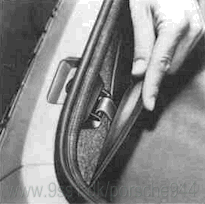 |
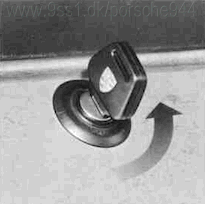 |
|||
| Hatchback (If vehicle is equipped with an anti-theft alarm see "Anti-theft alarm".) Release switch To unlock the hatchback, operate the control switch on the left side underneath the dashboard. If the hatchback does not open of its own accord, it must be raised by hand. Never operate the switch while the vehicle is in motion. |
Lock The hatchback can also be opened with the ignition/door lock key. Turn key counterclockwise and lift hatchback up. To close, push hatchback down firmly until both locks snap shut. Pull up on hatchback to make sure it is securely locked. Keep the hatchback locked at all times to prevent unauthorized access to the vehicle. Be careful when removing large objects through the rear. Sharp edged objects may damage the defogger wires in the rear window. |
WARNING Because of inherent hazards, we do not recommend transporting objects larger than those fitting safely into the luggage compartment. Keep the hatchback closed while driving to prevent poisonous exhaust gas from being drawn into the vehicle. |
||
| 56 | ||||
 |
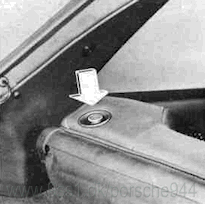 |
|||
| Luggage Compartment Luggage and other belongings should be protected from the sun and "inquisitive eyes" by pulling the rolled-up luggage cover from behind the rear seat back and hooking it into the eyelets on the rear cross wall. When unhooked, the cover rolls itself up automatically. To prevent luggage and other objects from sliding around while the car is in motion, you can secure them with spider straps available through your dealer or other supply firms. The eyelets for this purpose can be found behind the rear seat back and on the luggage compartment floor. |
Luggage space To provide for additional luggage space, press the knob on the left or right side to release the rear seat back. Then tilt forward. Luggage compartment light The light is located on the left side of the luggage compartment. The light can be switched on or off, regardless of ignition or vehicle light switch positions. Roofracks The installation of commercially available roofracks is not compatible with the roof design of your Porsche. |
When installing the Genuine Porsche Roof-rack available up till now, the maximum permissible weight load of 75 Ibs or 35 kg must not be exceeded. The "New Genuine Porsche Roofload Transport System" provides for maximum permissible weight loads of up to 165 Ibs or 75kg. Your Porsche dealer will be glad to advise you about which type of roofrack can best serve your individual needs and load carrying requirements. WARNING Make sure that the load is carefully mounted. Secure it additionally by locking the roof transport system. |
||
| 57 | ||||
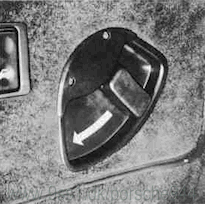 |
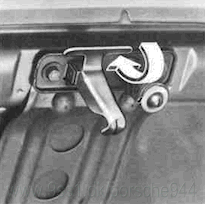 |
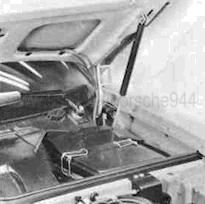 |
||
| Engine Hood To unlatch the engine hood, pull the release lever on the left underneath the instrument panel. |
Opening the hood Lift hood slightly and pull up on handle (arrow) to disengage safety catch. Then lift up the hood. Make sure the windshield wipers are not tilted forward. The engine compartment light on the hood will come on when the vehicle lights are turned on. |
Closing the hood Lower the hood and press it down on the hood latch until you hear an audible click. WARNING Should you notice at any time while driving that the hood is not secured properly, please stop at once and close it. |
||
| 58 | ||||
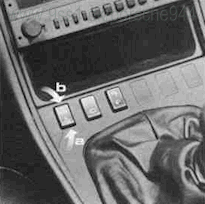 |
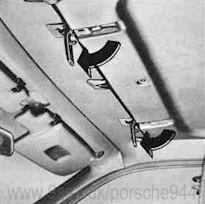 |
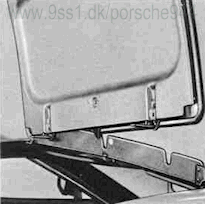 |
||||||||||||||||||
| Electric / removable prop-up roof With the ignition on, you can raise (a) or lower (b) the roof at the rear by depressing the front or rear half of the rocker switch in the center console. |
Removing roof Clean the roof prior to removal to avoid scratches and soiling your clothes.
|
Installing roof
|
||||||||||||||||||
| 59 | ||||||||||||||||||||
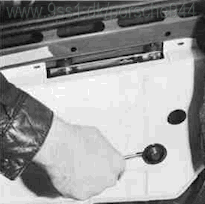 |
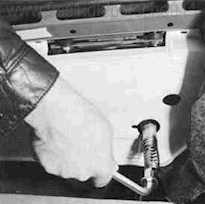 |
|||||||||||||
| Manual Operation If the electrical drive mechanism should fail, the roof can be closed manually. The motor for electrical operation is located at the left sidewall of the luggage compartment, behind the carpeting. |
|
|
||||||||||||
| 60 | ||||||||||||||
| Car Care Instructions |
||||||||||||||||||||
| Regular and correct care helps to maintain the value of your car and is also a precondition for the long-life guarantee. The Porsche paint finish is of a high quality baked synthetic enamel. The color and enamel type designation are indicated on the "paint number sticker". When buying touch-up paint, always give the paint and the car's identification numbers to your dealer. A well-cared for Porsche can look like new 10 years later. It all depends on the amount of care the owner is willing to give the car. Your Porsche dealer has a number of car-care products and can advise you which ones to use for cleaning the interior and exterior of your car. Whether you use Porsche recommended products or other commercially available cleaning agents first make sure of their correct application. |
WARNING
|
Washing and waxing The paint on your Porsche is very durable but must be protected from losing its luster due to outside influences. Therefore, wash and wax your Porsche often. The longer the dirt is left on the paint, the greater the risk of damaging the glossy finish, either by scratching if the dirt is rubbed into the paint, or simply by the chemical effect dirt particles have on the paint surface. Do not wash or wax in direct sunlight. Do not use hot water. Lukewarm to cool water is kinder to the paint. Pamper your Porsche! Wash it by hand! The mechanical brushes in an Automatic Car Wash may not reach every angle of the vehicle, and some tracks may cause damage to the underbody. Use plenty of water, a car-wash and wax solution and a soft sponge or hose brush. Begin by spaying water over the dry surface to remove all loose dirt before applying the car-wash and wax solution. Use plenty of water to rinse the vehicle off. Wipe everything dry with a chamois to avoid water spots. |
||||||||||||||||||
| 61 | ||||||||||||||||||||
| To guard against corrosion from the inside out, clean drain holes on the bottom of doors, tail gates, hatches etc., after each washing. Then wipe dry thoroughly. Also inspect all weatherstrips to make sure they do not allow water to enter the body panels. Do not aim the water jet directly at door, hatch or rear lid locks. Tape the key holes to prevent water from seeping into the lock cylinders. Water in lock cylinders should be removed with compressed air. To prevent locks from freezing in the winter, squirt glycerin or lock deicer into the lock cylinders. Do not use any solution that can damage the body paint. The underside of the vehicle picks up dirt and road salts used to keep streets and highways free of snow and ice. To guard against corrosion, it is important to remove mud, debris and road salt from the underside with a powerful jet of water. Be sure to include the wheel housings, bumpers, muffler, tailpipe and brackets. This should be done twice a year and is best accomplished after the vehicle has been driven through a heavy rain. Let engine and exhaust system cool down before washing. |
Waxing is not really needed when you have used a car-wash and wax solution. If you do not use a car-wash liquid with wax, apply wax to preserve the natural shine of the body paint. To obtain a long lasting finish, apply hard wax. Wax again if water remains on the surface in large patches instead of forming beads and rolling off. Exterior Care of the finish Oils contained in the paint are the most important ingredients contributing to the elasticity of the finish. Because these oils diminish gradually due to weather and similar causes, they must be replenished through regular and proper care of the finish. Given proper care, the original finish will retain its luster for many years. Ask your dealer for approved cleaning agents and preservatives. The use of polishes is recommended only after it becomes evident that the normal preservatives no longer accomplish the job. |
Dull finishes and plastics Plastic parts, such as light bulb lenses, decorative strips, panels, etc., will come clean during car washing. Should additional cleaning or spot removal be necessary, use a soft brush or cloth soaked with a mild detergent solution. Then rinse thoroughly and immediately with clear water. Do not use anything which could mar the plastic or dull finished surface, such as wax or polish, abrasive detergents or chemical cleaning solvents. Metal trim Bright or black anodized trim will come clean when you wash the vehicle. To protect the trim, use car wax. Touch-up paint Your dealer has touch-up paint for minor scratches and stone chips. Scratches should be touched up soon after they occur, to prevent corrosion. If corrosion formation becomes visible, however, a simple touch-up job will not suffice. The affected surface must be smoothed with sand paper and covered with an anti-rust primer, before restoring the painted finish. |
||
| 62 | ||||
| Tar or oil Do not allow tar or oil to remain on the paint. Remove as soon as possible with a cloth soaked with a special paint cleaner. If you do not have a tar or oil remover, you may substitute with turpentine. After applying a cleaning fluid, always wash with a lukewarm soap water solution and apply a new wax coat. Insects Remove as soon as possible with a lukewarm soap/water solution or apply insect remover. Tree sap Remove with a lukewarm soap/water solution. Do not allow tree sap or bird droppings to harden on the paint. Windows Keep silicone sprays off the windshield to avoid wiper smear in rain. Generally, highway dust that settles on the outside of the windshield contains material worn from tires and oil residues. On the inside surfaces of the windshields, particularly in strong sunlight, there are build-ups of dust from the interior decor. These buildups are reinforced by pollution in the air |
brought in with the fresh air supply. Use a lukewarm soap/water solution or an alcohol based commercial window cleaning agent for the inside and outside. If a chamois is used for polishing the glass, it should exclusively be used for that purpose. To assure that windshield washers also function at freezing temperatures, antifreeze must be added to the washer fluids reservoirs beforehand. It is advisable to use window washer solvent with anti-freeze all year round. Follow directions on the can for the right amounts to be used. Do not use engine coolant anti-freeze or any other solution that can damage the paint. In vehicles with Sekuriflex windshields, the plastic coating on the inside of the windshield must not have gummed labels put on it or be cleaned using abrasive agents or dry methods. If very dirty, it can be cleaned with benzine. The use of benzine in a confined environment may be dangerous to your health. Make certain that the plastic coating is not damaged in cleaning by hard objects such as jewelry or wristwatches. Do not remove ice on the inside of the windshield by any means except warm air from the defroster nozzles. Do not use any deicer sprays, scratching tools, or scrapers! |
A foil base must be applied to the windshield prior to application of any labels or stickers such as those used for state registration or inspections. Failure to utilize foil base between sticker or label and the Sekuriflex coating will result in damage to the Sekuriflex coating. Three foil bases were included with the vehicle and additional foil bases may be ordered from any Porsche dealer. Instructions:
|
||||||||||||||||||
| 63 | ||||||||||||||||||||
| When removing the label/sticker or the backing foil, first spray the foil with a soapy solution (see point 4). Wiper blades Always loosen frozen wiper blades from glass as they may tear otherwise. Remove all wiper blades periodically and clean them thoroughly with an alcohol base cleaning solution. Use a sponge or soft cloth and wipe lengthwise. Weatherstrips To seal properly, weatherstrips around hood, hatch, windows, doors, etc., must be pliable. Spray with silicone or coat with talcum powder or glycerin to retain flexibility of the rubber and to protect against freezing in the winter. Light alloy wheels To preserve the decorative appearance of the light aluminium castings, some special care is necessary. Aside from road dirt and salt sprays, brake metal dust will exert corrosive effects. If left on too long, brake metal dust can cause pitting. Wash the wheels with a sponge or hose brush every other week. |
Roads salts should be removed weekly with an acid free cleaning solution. The acid free cleaning solution must not have a pH value greater than 10 (see explanation), in case of doubt, it is recommended to check with the manufacturer of that particular cleaner. Every three months (after regular cleaning) the wheels should be coated with petroleum jelly. Rub it in firmly with a soft cloth. Never use abrasive or metal polishing cleaning agents. Explanation of pH value The pH value is a measurement for the hydrogen-ion concentration in a liquid. This value tells if the liquid reaction is sour (acid) or alkaline (lye solution). At a pH value of 7, the reaction of the liquid is neutral (that is, chemically clean water), it is not an acid or alkaline. Acids have a pH value under 7, the strength of the acid increases with a lower pH value. Alkaline lies between a pH value of 7 and 14, the strength of the alkaline increases with higher pH values. |
For example: a mineral water mixed with carbon dioxide has a pH value of 6-6.5, reaction is also light sour. Battery acid in comparison has a pH value of 1. or the pH value for normal soap solution is 8-9, but the soap solution for a dishwasher is approximately 12.5, this would not be suitable for wheel cleaning. Your Porsche dealer can advise you which product to use. Remember that moisture and road salt on brakes may affect braking efficiency. Test the brakes after each car or wheel wash. |
||
| 64 | ||||
| Interior Glass Use the same cleaning agents as for the exterior and polish dry with a soft cloth or paper towel. Fabric Use a vacuum cleaner or a soft bristle brush to remove dust and loose dirt from carpeting, upholstery, headliner and other trim. Dirt stains can usually be removed with lukewarm soap water or an all purpose cleaner solution, or a dry foam cleaner. For greasy, oily and other stubborn stains, use a spot remover. Do not pour the liquid on the fabric. Dampen a clean cloth and rub carefully, starting at the edge and working inward. Safety belts Keep belts clean. Very dirty belts may not retract properly. Do not remove belts from the vehicle to be cleaned. Do not use chemical cleaning agents, bleach or dyes. They contain corrosive properties which will weaken the webbing. Do not allow inertia reel safety belts to retract before they are completely dry. |
For cleaning, use a mild soap water solution. Let belts dry out thoroughly and away from direct sun light. Plastic, vinyl and leatherette Use a clean, damp cloth or sponge to keep this trim free from dust. For other spoilage, use a lukewarm all purpose cleaning solution or a mild saddle soap for vinyl and leather trim. Remove water spots and soap traces with a clean, damp cloth or sponge. Use a clean, soft cloth to rub dry. Grease, tar or oil stains can be removed with a clean cloth or sponge soaked with all purpose cleaner or with a solvent type vinyl or leather cleaning agent. Occasionally apply a colorless vinyl or leather preservative to retain the material's luster and pliability. Leather and leather trim To keep leather seats and trim beautiful and soft, they should be cleaned and cared for regularly. Clean leather with a soft, white woolen cloth and a mild soapwater solution. Do not use chemical or abrasive cleaning agents. Do not let moisture seep through perforated surfaces to safeguard against corrosion and cracking from underneath. After cleaning, apply a leather preservative re- |
commended by Porsche to all dry surfaces with a clean and soft woolen cloth. Let your Porsche dealer advise you on the use of the leather preservation product. Corrosion protection The engine compartment, as well as all engine, transmission, front and rear axle assembly surfaces have been treated with a wax based coating at the factory for protection against corrosion. WARNING Do not apply additional undercoating or rustproofing on or near the exhaust manifold, exhaust pipes, catalytic converter or heat shields. During driving, the substance used for undercoating could overheat and cause a fire. Engine Compartment If it becomes necessary to steam clean or otherwise wash the engine compartment, the wax based protective coating is usually lost. It is therefore important to reapply this protective coating to all engine compart- |
||
| 65 | ||||
| ment panels, flanges, cavities, seams and engine assembly surfaces. When washing the engine compartment, only use commercially available grease cutting solvents made especially for this purpose. Carefully follow directions printed on the container by the manufacturer. Chassis The lower body shell of your Porsche is thoroughly protected against corrosion. However, it is recommended to have the underbody inspected twice a year. Any detected damage to the undercoating, due to road hazards, should be repaired promptly. Oil based protective sprays must not be applied. Only tar or wax based anti corrosion protectors are compatible with the factory applied undercoating. Before application, road dirt and oily substances must be removed. Whenever the lower body shell, axle, transmission or engine assemblies are repaired, the lost anti-corrosion coating of the affected surfaces should be renewed. Let your Porsche dealer advise and assist you. |
||||
| 66 | ||||
| Exercise Extreme Caution when Working under the Engine Hood |
||||||||||||||||||||||||||||||||
The engine compartment of any motor vehicle is a potentially hazardous area. If you are not fully familiar with proper repair procedures, do not attempt the adjustments described on the following pages. This caution applies to the entire vehicle.
|
|
|
||||||||||||||||||||||||||||||
| 67 | ||||||||||||||||||||||||||||||||
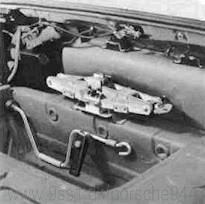 |
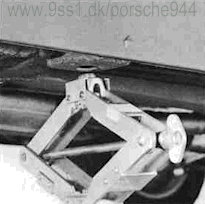 |
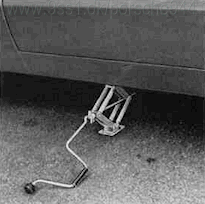 |
||||||||
| Tool Kit and Car Jack The tool kit and jack are stored in the luggage compartment under the floor mat. The car jack must be screwed open a little before it can be removed from the holder. The tool kit contains tools needed for minor emergency roadside repairs, adjustments and wheel changing. Regulations in some countries require additional tools. Details should be obtained prior to leaving for a foreign country. |
WARNING
|
|||||||||
| 68 | ||||||||||
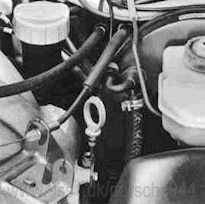 944 |
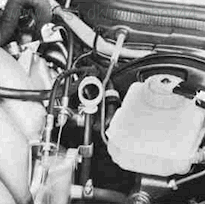 944 S |
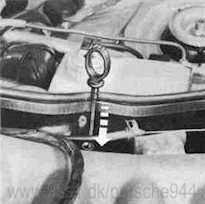 944 Turbo |
||||||||||||||||||
| Engine Oil Level Engine oil consumption It is normal for your engine to consume oil. The rate of oil consumption depends on the quality and viscosity of oil, the speed at which the engine is operated, the climate, road conditions as well as the amount of dilution and oxidation of the lubricant. Because of these variables, no standard rate of oil consumption can be established, but drivers should expect an increased oil consumption at high speeds and when the engine is new. |
|
Checking oil level To get a true reading, the car should be on level ground. After turning off the engine, wait a few minutes for the oil to return to the oil sump.
|
||||||||||||||||||
| 69 | ||||||||||||||||||||
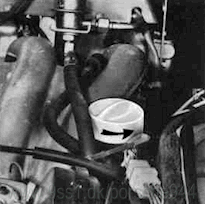 |
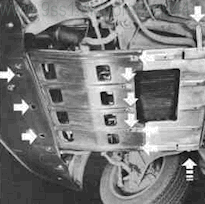 |
|||||||||||
| Adding engine oil Only add the amount of oil that is needed. The correct oil grade and viscosity recommendation is given under "Engine Oils".
The oil filler cap and dipstick must be secure to avoid oil spills and resulting fire hazard. |
944-Turbo Engine Guard Before working on the underside of the engine for the 944 Turbo, remove the two-part engine guard. |
|||||||||||
| 70 | ||||||||||||
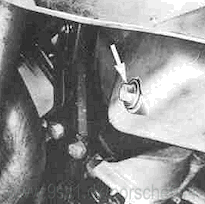 |
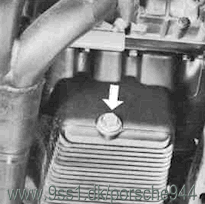 |
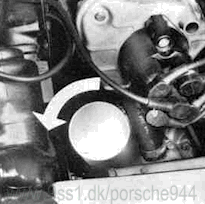 |
||||||
| Changing Engine Oil and Filter High quality-multi-grade oils are suitable for all year round driving. Seasonal oil changes are therefore not necessary. Only if multi-grade oils are not readily available, a single-grade oil of the correct viscosity can be used. Specifications of the various oils to be used are detailed under "Filling Capacities and Engine Oil". The use of oil additives is not recommended by Porsche. |
WARNING
|
(when in doubt, consult local authorities), please have the oil changed by your dealer or a service station. Oil change intervals specified in the Warranty & Maintenance booklet accompanying the vehicle apply to normal operating conditions and must be adhered to, including intervals for oil filter change. If you drive mostly short distances, or if you operate the vehicle in dusty areas, or under predominantly stop-and-go traffic conditions, or when temperatures remain below freezing for extended periods, the engine oil should be changed more frequently. When changing the engine oil and the oil filter, the splash shield under the car has to be removed first. Drain the oil when the engine is still warm. |
||||||
| 71 | ||||||||
The oil filter should be changed at the inter- vals listed in your Maintenance Schedule.
|
||||||||||||||||||||
| 72 | ||||||||||||||||||||
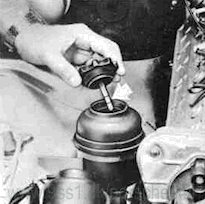 |
||||||||
| Power Assisted Steering The hydraulic assistance system allows effortless steering under all driving conditions. Slight hissing or squeaking sounds during sharp turns (turning steering wheel from lock to lock) are normal and do not indicate a defective steering mechanism. If the engine is not running, power assisted steering is no longer effective. You can continue to steer the car but more effort will be required to turn the steering wheel. |
Checking the fluid level The hydraulic fluid level should be checked at regular intervals. The fluid reservoir is mounted on the right wheel housing in the engine compartment.
3. Reinstall cap and handtighten securely. |
|||||||
| 73 | ||||||||
| Cooling System |
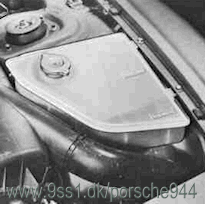 |
|||
| Only use additives recommended for aluminium engines and radiators. Your Porsche dealer will be able to advise you. For year round driving, phosphate-free antifreeze is added at the factory for temperatures down to: -31° F / -35° C Because of its anti-corrosion properties, antifreeze should also remain in the cooling system for summer operation. Cooling system capacity and specified antifreeze and water ratios are listed under "Filling capacities". Use any quality phosphate-free anti-freeze containing ethylene glycol, available at your Porsche dealer. Anti-freeze other than specified by Porsche for aluminium engi- |
nes and radiators may cause corrosion of the cooling system, leading to engine overheating and damage. Only for topping up coolant, a small amount of anti-freeze containing ethylene glycol and phosphates may be used if recommended anti-freeze is not available. The anti-corrosion properties and the antifreeze consistency will diminish gradually. We recommend renewing the coolant mixture at least every 2 years. WARNING The radiator fan is electrically driven. It is switched on automatically by a thermostat when the coolant reaches 198°F / 92°C. |
Even when the engine is turned off, the fan will continue running, until the coolant temperature has dropped to 189°F / 87°C and until the engine itself has cooled down sufficiently. Checking coolant level in expansion tank A correctly functioning cooling system requires only minor care. The coolant level should be checked from time to time, and always before going on a longer trip. The expansion tank with filler cap opening is located in the engine compartment (see illustration). Since the expansion tank is transparent, the coolant level can be checked visually without removing the filler cap. |
||
| 74 | ||||
| When the engine is cold, the coolant level should reach the minimum mark on the expansion tank. When the engine is warm, the coolant level will be above the minimum mark. Since the closed cooling system loses almost no coolant, topping up is normally not required. An obvious loss of coolant indicates leakage. In this case contact your dealer. WARNING
|
A warm engine should only be topped up if the coolant level has dropped appreciably below the minimum mark. Too much added coolant will escape through the pressure cap when coolant warms up. If more than about 1.06 U.S qt or 1 liter must be added, the cooling system should be bled. |
Winter operation At the beginning of the winter season, have the coolant checked for anti-freeze concentration. The ratio between water and anti-freeze necessary to prevent freezing depends on the anticipated outside temperatures. The ratios can be taken from the mixing chart listed under "Filling Capacities" or from the container of the antifreeze manufacturer. Increasing the anti-freeze in the coolant further than shown on the container is not only uneconomical, it is also detrimental to engine cooling. |
||||||
| 75 | ||||||||
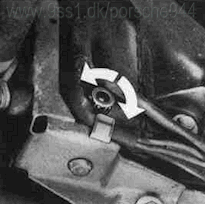 |
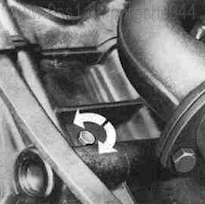 |
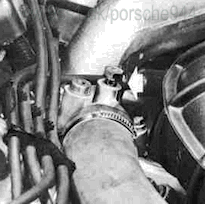 944 |
||||||||||||||||||||||||
| Draining the coolant Engine must be cold
|
Bleeding cooling system
and topping up coolant
|
|
||||||||||||||||||||||||
| 76 | ||||||||||||||||||||||||||
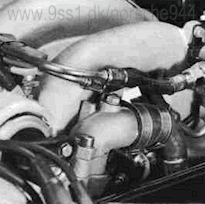 944 S |
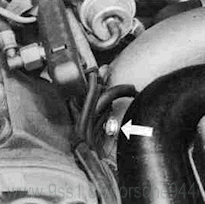 944 Turbo |
|||||||||
|
Manual Transmission oil Both transmission and final drive are combined in one housing. The lubricant used is hypoid oil. The manual transmission oil should be checked and changed by your Porsche dealer and at the intervals specified in your Maintenance Schedule. |
|||||||||
| 77 | ||||||||||
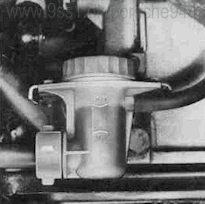 |
||||
| Automatic Transmission Fluid The torque converter and the transmission are lubricated with Automatic Transmission Fluid (ATF). The final drive requires hypoid oil SAE 90 only. Do not tow the car or run the engine without ATF in the transmission. Checking the ATF level The ATF has to be checked at frequent intervals, for instance, when the engine oil is being checked or at least at the specified intervals (see Maintenance schedule). A correct ATF level is very important for the proper functioning of the transmission. The |
reading should be done when the ATF is warm, with the engine idling, the selector lever in Neutral and the parking brake applied. The level of the ATF fluid can be checked visually through the transparent reservoir. This reservoir is located at the rear end of the transmission housing. You have enough ATF if the fluid level is between the Min. and Max. marks. It should never be above or below these marks. The difference between the two marks is 1 U.S. pint or 0.4 liter. If level is too high or too low do not just add or drain ATF. Have your dealer check and correct the cause as soon as possible. For correct ATF specifications, see "Filling Capacities". |
Changing the ATF The ATF and the hypoidoil in the final drive has to be changed at specified intervals (see Maintenance schedule). |
||
| 78 | ||||
| Brake Fluid Reservoir The brake fluid reservoir is in the engine compartment. The reservoir has two chambers, the front chamber for one brake circuit and the rear chamber for the second brake circuit and the hydraulic clutch. The fluid level should be checked regularly. If the level drops below the "min" mark on the transparent reservoir, the cause should be located and corrected by your dealer. To add brake fluid, unscrew the cap. The vent bore in the cap should be kept clean and open. |
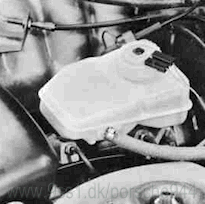 |
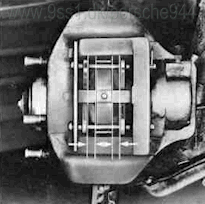 944 / 944 S |
||||||||||||||
WARNING
|
|
Checking Brake Pads Brake pad wear will mainly depend upon the degree of usage, and the type of driving you do. Thickness of the pads should be checked during regular maintenance or whenever the wheels are taken off (visual check). The brake pads must be thick enough between the brake pad plate and the cross spring to allow a reserve for further wear (see illustration). |
||||||||||||||
| 79 | ||||||||||||||||
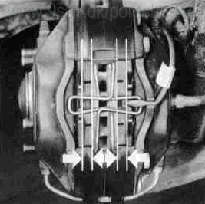 944 Turbo |
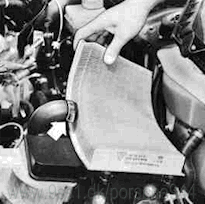 944 |
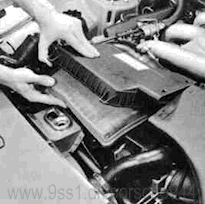 944 Turbo |
||||||||||
| The permissible wear limit has been reached once the brake pad plate comes to rest against the cross spring (brake pad thickness approx. 0.08 in or 2 mm). We also suggest that the condition of the brake pads be checked prior to going on long trips. |
Air Filter A dirty air cleaner not only reduces engine performance, but can lead to premature engine wear. If driving is mostly done in areas where the air is very dusty, the air cleaner must be checked and cleaned frequently, perhaps daily. The paper filter element must never be cleaned or soaked with gasoline, cleaning solvents or oil. |
To clean or replace the filter element 944 / 944 Turbo
|
||||||||||
| 80 | ||||||||||||
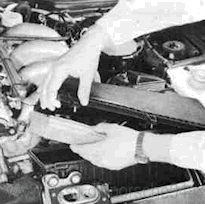 944 |
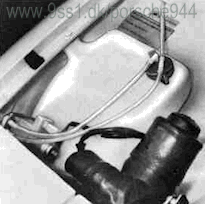 |
|||||||||||||
|
944 S
|
Reservoir for Windshield and Headlight Washer System The transparent reservoir is in the engine compartment. As clear water is usually inadequate for cleaning windshield or headlights, add a cleaning solution, such as windshield washer solvent and antifreeze offered by your dealer. To assure that the system also functions at freezing temperatures, antifreeze must be added to the water beforehand. Follow the instructions on the can for the right amount to be used (also see "Filling Capacities"). Do not use engine coolant anti-freeze or any other solution that can damage the car paint. |
||||||||||||
| 81 | ||||||||||||||
| Tires/Wheels The original equipment tires and wheel rims on your Porsche comply with all applicable Federal Motor Vehicle Safety Standards. For your driving safety remember the following:
WARNING Incorrect tire pressures cause increased tire wear and adversely affect road holding of the vehicle, leading to loss of control. Always use an accurate tire pressure gauge when checking inflation pressures. Do not exceed the maximum tire inflation pressure listed on the tire sidewall. (Also refer to "Technical data"). Cold tire infla- |
tion pressure means: when a car has not been driven for at least 3 hours or less than 1 mile. Never let any air out of warm tires to meet cold tire pressure specifications. Tire traction WARNING When driving on wet or slushy roads, a wedge of water may build up between the tires and the road. This phenomenon is known as aquaplaning and may cause partial or complete loss of traction, vehicle control or stopping ability. Reduce speed on wet surface. Tire Life Tire life depends on various factors, i.e., roads, traffic and weather conditions, driving habits, type of tires and tire care. Inspect your tires at least every 2.000 miles or 3.000 km for wear and damage. If you notice uneven or substantial wear, wheels might need alignment or tires should be balanced or replaced. Tires must always remain on same side of vehicle. After changing, adjust tire pressure and torque wheel nuts diagonally to 94 ft Ibs (130 Nm) (see "Changing wheels"). The supposition that tire durability and performance are immune to the effects of storage and age is unfounded. Chemical additives, which make the rubber elastic, lose their effectiveness in the course of time and the rubber becomes brittle and cracks. |
Therefore, the tires, especially the collapsible spare tire, should from time to time undergo a visual check. To accomplish this, pump up the collapsible spare tire. Under no circumstances should tires older than 6 years be used on your Porsche. The age of the tire can be obtained from the "DOT" code number. If, for example, the last three numbers read 125, then the tire was produced in the 12th week of 1985. Tire wear The original equipment tires on your Porsche have built-in wear indicators. They are molded into the bottom of the tread grooves and will appear as approximately 1/2 in (12 mm) bands when the tire tread depth is down to 1/2 of an in (1.6 mm). When the indicators appear in two or more adjacent grooves, it is time to replace the tires. We recommend, however, that you do not let the tires wear down to this extent. Worn tires cannot grip the road surface properly, and are even less effective on wet roads. In the United States, state laws may govern the minimum tread depth permissible. Follow all such laws. WARNING Do not drive with worn tires or tires showing cuts or bruises as they may lead to sudden deflation. If you notice that tires are wearing unevenly, consult your Porsche dealer. Uneven wear |
||||||||||
| 82 | ||||||||||||
| may not always be due to improper wheel alignment. It can be the result of individual driving habits such as cornering at high speeds. If the tire pressure is not checked and adjusted regularly, abnormal tire wear can also occur. Tire care WARNING
Tire replacement In the interest of maximum safety and best all-around car handling, always buy replacement tires that have the same specifications with regard to tire size, design, load carrying capacity, tread pattern, tread depth etc. This also applies to Porsche recommended alternate replacement tires. If you do not use a Porsche recommended replacement tire, make sure that you purchase your new tires from a reputable |
tire specially dealer and that the dealer complies with all manufacturers warnings for those tires. In case of tire damage where it is uncertain whether there is a break in the ply with all its consequences or, tire damage caused by thermal or mechanical overloading due to a loss of pressure or any other prior damage, we recommend that the tire be replaced for safety reasons. If one faulty tire on an axle is replaced it should be noted that the difference in tread depth on one axle must not be more than 30%. Tire specifications are imprinted on the sidewall of the tires. If in doubt, check with your Porsche dealer. When replacing tubeless tires, always install new valve stems. When replacing tires requiring an inner tube, always install new tubes. New tires do not possess maximum traction. They tend to be slippery. Break new tires in by driving at moderate speed for the first 60-120 miles or 100-200 kilometers. Wheel balancing A wheel should always be balanced after a tire repair. Even with regular use a wheel can get out of balance, and should therefore be balanced from time to time. Unbalanced wheels may affect car handling and tire life. When balancing light alloy wheels, use only adhesive balancing weights supplied through the Porsche parts service. |
Wheels If you intend to use other than original equipment wheels, be sure that they conform to Porsche specifications for your model. Check with your Porsche dealer regarding the correct wheel specifications for type and model year. Removing and storing tires The driving direction should be clearly marked on all tires before removing them for storage, to make sure they are mounted and run in the same direction as before. Store tires in a cool and dry place. Tires without rims upright! Avoid contact with oil, grease or gasoline. When remounting, put tires with the most tread depth at the front. Snow tires For a better grip on snow and ice use radial M + S tires or snow tires with studs. Check with your local Motor Vehicle Bureau for possible restrictions. Radial ply M+S tires should be inflated with the same cold tire inflation pressures required for the regular radial ply tires. However, do not exceed the maximum tire inflation pressure listed on the tire sidewall. Snow tires should have the same load capacity as original equipment tires and should be mounted on all four wheels. Snow tires with studs should be run at moderate speeds when new in order to give the studs time to settle. |
||||||||||||||
| 83 | ||||||||||||||||
| WARNING Tires with badly worn treads and studs are very dangerous. Make sure they are replaced immediately. Do not drive a vehicle equipped with snow tires at prolonged high speed. Snow tires do not have the same degree of traction on dry, wet or snow free roads as a normal tire. Furthermore, snow tires wear rapidly under these conditions. Snow tires do not fulfill their purpose if the tread depth is less than 5/32 in. / 4 mm. Comply with all state and local laws governing snow tire and tread depth requirements. |
Snow chains Should snow chains be necessary, they must be mounted on the drive wheels only. Check with local authorities for possible restrictions. Use only Porsche-approved snow chains with fine pitch links, so that enough space remains between the chains and the inside of the wheel arches. Drive wheels must rotate freely with chains mounted to prevent damage to body, axle or brake components. Follow instructions issued by the supplier of the chains. Remove chains as soon as roads are free of ice and snow. |
New Tire Identifications The European tire manufacturers have changed their tire identification system for SR and HR-tires pertaining to maximum permissible speed and maximum load carrying capacity for belted tires. The following is an example only. During the transition period some tires might show both old and new identification codes, such as: 215/60 SR 15 M+S 80 Q. In this instance, the new codes apply. The identification codes for VR tires remain unchanged; for example: 205/55 VR 16. (V = maximum permissible speed for radial tires, i.e. over 130 mph or 210 km/h). |
||
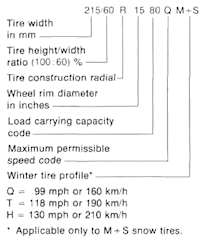 |
||||
| 84 | ||||
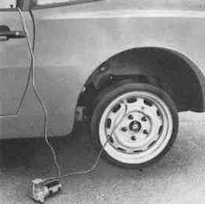 Collapsible Spare Tire The spare tire is stored underneath the luggage compartment cover. Due to tread and space saver design features of the collapsible tire, car handling may be affected. Therefore, do not drive more than 50 mph (80 km/h) when using the collapsible spare tire. It is for emergency use and short distances only. Remount the original road tire as soon as possible. |
Inflating the collapsible tire WARNING Do not overinflate your spare tire. Inflate the collapsible tire with the electric air compressor that comes with your Porsche. Do not use other equipment!
The collapsible spare tire cannot be repaired or mounted on the rims with standard workshop equipment. Repair and remounting must only be done by the tire manufacturer. |
Tire tread depth As required by law, the tread depth of the collapsible tire is the same as that of the original equipment tire. Replace a worn collapsible spare tire in time. If air compressor does not work
Maintenance of air compressor The air compressor is maintenance-free. Do not apply oil or any other lubricant. The air filter should be cleaned periodically to assure maximum efficiency of the unit. |
||||||||||||||||
| 85 | ||||||||||||||||||
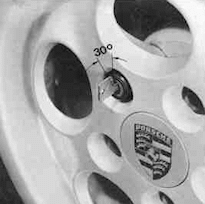 |
||||||||||||||||||
| Lockable Wheel Nuts You can guard against wheel theft by installing lockable wheel nuts on your wheels. Each kit contains three keys and four wheel nuts with lock sleeve. The locking mechanism is identical for all four wheel nuts. When taking the vehicle to your Porsche dealer or to a workshop for wheel or tire service, remember to leave one key with the service attendant. In case of loss, duplicate keys cannot be furnished by your Porsche dealer. Do not leave these keys in the vehicle. Keep them in a safe place. |
To unlock a wheel
|
To lock a wheel
|
||||||||||||||||
| 86 | ||||||||||||||||||
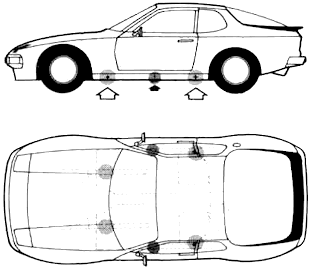 |
Jack support points Black arrow: Jackport for car jack White arrows: Lift points for workshop hoist or floor jack front on the inboard side members rear on the side reinforcement brackets Jacking at any other place may damage the vehicle or may result in personal injuries. |
|||||||||||||||||||||||||||||||||||
| Changing a Tire WARNING - Failure to follow these instructions may result in serious personal injuries to you or to bystanders.
|
|
|
||||||||||||||||||||||||||||||||||
| 87 | ||||||||||||||||||||||||||||||||||||
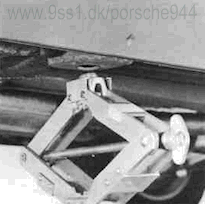 |
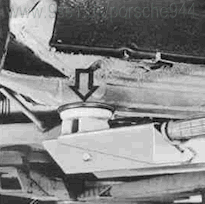 |
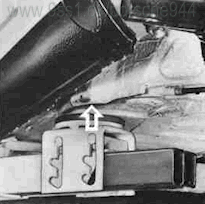 |
||||
| Lifting Vehicle The jack ports are located below the middle of the door underneath the left and right rocker panels, hidden from view. Lifting with car jack The car jack must never be used as a support to work underneath the vehicle. If the jack is accidentally dislodged, you could be seriously injured. When working under the vehicle always use safety stands specifically designed for this purpose. WARNING
|
The vehicle should never be lifted or jacked up from underneath the engine oil pan, the transmission housing, or the front or rear axle. This could lead to serious damage. Lifting with workshop hoist Make sure there is sufficient clearance between pads and vehicle before driving vehicle onto hoist, especially if the vehicle has a large front panel or spoiler. The vehicle must be lifted only at the lift points illustrated. The front lift points are located on the inboard side members of the underbody. The rear lift points are located on the side reinforcement brackets of the underbody. |
Take care to avoid damaging critical components which are close to the lift points. WARNING When removing components such as engine block, transmission housing, fuel tank, wheels, front or rear axle, anchor vehicle to hoist or add corresponding weights to maintain the center of gravity. Otherwise the vehicle might tilt or slip off the hoist, causing serious damage or personal injury. Lifting with floor jack The same lift points as illustrated for the hoist also apply when using a floor jack. To avoid damage to the underbody or chassis frame, it is necessary to insert a rubber pad between the floor jack and the lift points. |
||||
| 88 | ||||||
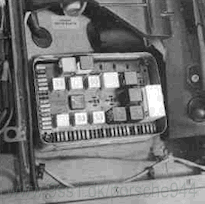 |
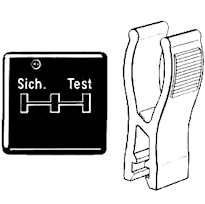 |
If it fails to light up, the fuse is defective and must be replaced. Replace black plastic cover. The central electrical system contains plug in relays for various electrical switching functions. Defective relays should be tested and replaced by an authorized Porsche dealer. To prevent damage to the electrical system we recommend having all work - including the installation of electrical accessories -carried out by your authorized Porsche dealer. . , |
||
| Fuses and Relays The individual circuits are protected by fuses to prevent damage to electrical leads and components due to short-circuits and overload. The fuse box with a black plastic cover is located on the left side in the engine compartment directly in front of pivot point for left windshield washer arm. The use of the fuses and relays is shown in a list on the inside of the cover of the fuses and relays. Replacing a Fuse Before replacing a fuse, turn off all electrical components and the ignition; remove |
the key. Replacing a fuse or relay with the engine running or the ignition on could cause electrical shock. A blown fuse indicates an overload in the circuit. When a fuse is blown it is not sufficient to merely replace it. The cause of the short circuit or overload must be located. Fuses should never be patched up with tin foil or wire as this may cause serious damage elsewhere in the electrical circuit. Open snap-on latches and remove plastic cover. To find out whether a fuse is serviceable, pull it out with the plastic pliers specifically provided for this purpose. Insert the fuse at the test point on relay (G 3). If the fuse is in proper condition, the green indicator light will come on. |
Loudspeakers When installing a radio or booster amplifier, check that the output is compatible with the capacity of the loudspeakers supplied with the vehicle. Rated capacity in Watt (Sinus) Front Rear 2x10 2x10 HiFi Audio Package 2 x 25 2 x 25 |
||
| 89 | ||||
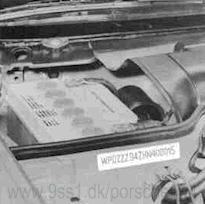 Battery-12 Volt The battery is located under the front hood in the cowl area. A replacement battery should always have the same rating as the original equipment battery. Specifications are printed on the battery housing. Before work is done on the electrical system, the battery must be disconnected to prevent short circuiting. First disconnect the negative ground wire and then the positive cable. To reconnect battery, reverse the procedure. Disconnecting the battery while the engine is running will damage the alternator. This also applies to cars equipped with a battery main switch. |
Never drive the car with a disconnected battery as this will damage the alternator. WARNING
The electrolyte fluid level in your battery can be checked by unscrewing and opening the filler vent caps of each cell. The fluid level should meet the indicator mark in each cell. If necessary, top off with distilled water. How often water must be added depends on operating conditions and on the time of year. Generally, the electrolyte level must be checked more often in the summer than in the winter, and more often when driving long distances. |
Only fill up to mark, otherwise the electrolyte will overflow when the battery is being charged and cause damage. Battery care
During the winter months, battery capacity tends to decrease as temperatures drop. Additionally, more power is consumed while starting, and the headlights, heater, rear window defogger, etc., are used more frequently. Curtail unnecessary power consumption, particularly in city traffic or when travelling short distances only. Let your Porsche dealer test the battery's capacity before winter sets in. A well charged battery will not only prevent starting problems but will also live longer. Battery charging Automotive batteries lose their efficiency when not in use. The charge available in your battery can be measured with a hydrometer. We recommend that battery voltage be tested by your Porsche dealer who has the appropriate equipment. If the car is not driven for prolonged periods, the battery |
||||||||||||||||||
| 90 | ||||||||||||||||||||
| must be charged at least every 6 weeks. A discharged battery allows rapid formation of sulfates, leading to premature deterioration of the plates. WARNING
WARNING Heed all warnings and follow instructions that come with your battery charger. |
|
|||||||||||||||||||||||||||||||
| 91 | ||||||||||||||||||||||||||||||||
| Emergency Starting with Jumper Cables WARNING
|
How to use jumper cables WARNING
Always connect POSITIVE (+) to POSITIVE (+), and NEGATIVE (-) to ground on engine block.
|
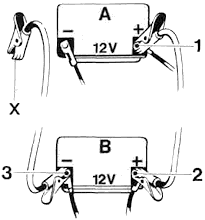 A - Discharged Battery B - Booster Battery Do not try to start car by pushing or towing. Damage to the catalytic converter, the transmission, and/or other components of the car may result. |
||||||||||||||||||||||||||||||||||||||||
| 92 | ||||||||||||||||||||||||||||||||||||||||||
| Replacing Bulbs |
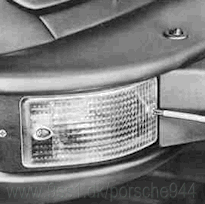 944 / 944 S |
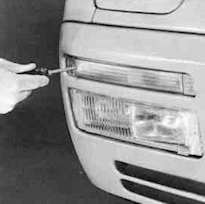 944 Turbo |
||||||||||||
| To avoid short circuits, turn off the respective electrical components when changing light bulbs. Keep bulbs free of grease and dirt. Hold them only with a clean cloth or soft paper. Do not use chemical cleaning agents on the plastic lenses. Plastic lenses should only be cleaned with water or a mild soap/ water solution. We recommend that you have an assortment of spare bulbs in the car. When traveling abroad don't forget that some countries require spare bulbs as part of the safety equipment. |
Front - Turn Signal Lights / Parking Lights
|
6. Check lights. |
||||||||||||
| 93 | ||||||||||||||
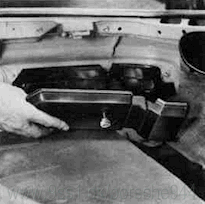 |
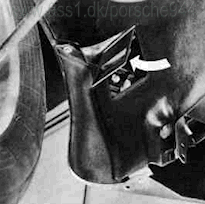 Front |
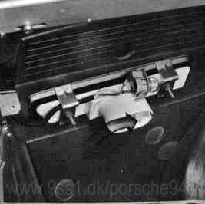 Rear |
||||||||||||||||||||||
| Rear - Turn Signal Lights / Stop Lights / Parking Lights / Back-up Lights
|
Side Marker Lights To change the bulb, open the flap at the front of the plastic shell beneath the fender. The rear housing is in the stowage well beneath the mat.
|
|||||||||||||||||||||||
| 94 | ||||||||||||||||||||||||
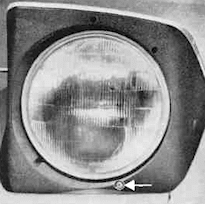 |
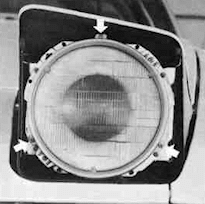 |
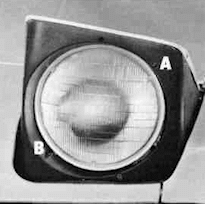 |
||||||||||||||||||
| Sealed Beam Headlights Replacing light units
|
Adjusting Headlights Headlight adjustment should be done with a headlight aiming device under the following conditions: At curb weight of car (i. e. car ready for use and with full fuel tank). |
Driver's seat should be occupied by a person or a weight of approx. 165 Ibs (75 kg). Tire pressure must be correct. Roll car forward a few feet so that the suspension seeks its normal position. Headlight adjustment screws Screw "A" (lateral adjustment) right turn = beam moves right left turn = beam moves left Screw "B" (vertical adjustment) right turn = beam moves up left turn = beam moves down |
||||||||||||||||||
| 95 | ||||||||||||||||||||
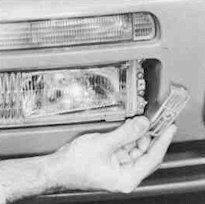 944 Turbo |
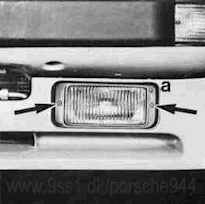 944 / 944 S |
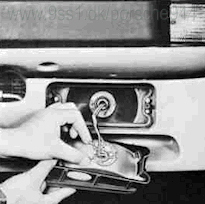 944 / 944 S |
||||||||||||
| Fog Lights On the 944 Turbo, before adjusting or removing the fog lamp unit, loosen the transparent side parts which are secured with Phillips-head screws. |
|
|
||||||||||||
| 96 | ||||||||||||||
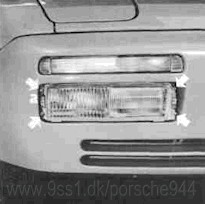 944 Turbo |
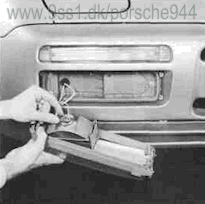 944 Turbo |
|||||
Screw "a" (vertical adjustment) right turn = beam moves down left turn = beam moves up |
||||||
| 97 | ||||||
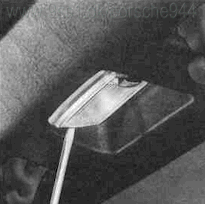 |
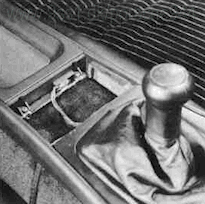 |
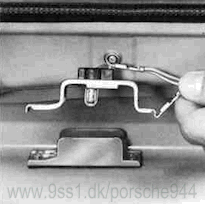 |
||||||||||||||||||||||||||
Interior Light
|
Ashtray Light
|
License Plate Light
|
||||||||||||||||||||||||||
| 98 | ||||||||||||||||||||||||||||
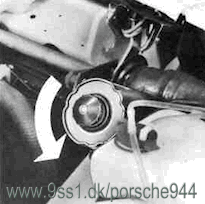 |
||||||||
| Manual Operation of Retractable Headlights If the retractable headlights do not open, they can be operated manually by turning the knob on the end of the motor drive shaft located in the front of the engine compartment. The connecting rod assembly is designed in such a way that it need only be turned to the left to either close or open the headlights. |
WARNING
|
|||||||
| 99 | ||||||||
| Emission Control System |
||||||||||||||||||
| In the Interest of Clean Air Pollution of our environment has become a problem that is of increasing concern to all of us. We urge you to join us in our efforts for cleaner air in controlling the pollutants emitted from the automobile. Porsche has developed an emission control system that controls or reduces those parts of the emission that can be harmful to our environment. Your Porsche is equipped with such a system. Porsche warrants the Emission Control System in your new car under the terms and conditions set forth in the Warranty & Maintenance booklet. You, as the owner of the vehicle, have the responsibility to provide regular maintenance service for the vehicle and to keep a record of all maintenance work performed. To facilitate record keeping, have the service performed by authorized Porsche dealers. They have Porsche trained mechanics and special tools to provide fast, efficient service. |
WARNING To assure efficient operation of the Emission Control System:
|
Starting
Parking
Undercoating
|
||||||||||||||||
| 100 | ||||||||||||||||||
| How Emission Control Works |
||||||||||||
| When an automobile engine is running, it uses energy generated through the combustion of a mixture of air and fuel. Depending on whether a car is driven fast or slowly or whether the engine is cold or hot, some of the fuel (hydrocarbons) may not be burned completely but be discharged into the engine crankcase or exhaust system. Additional hydrocarbons may enter the atmosphere through evaporation of fuel from the fuel tank. These hydrocarbons (HC), when released into the air, contribute to undesirable pollution. In addition, carbon monoxide (CO) and oxides of nitrogen (NOx) contribute to engine emissions. They, too, are formed during the combustion process and discharged into the exhaust system. To reduce these pollutants, your Porsche is equipped with a precisely calibrated fuel injection system to assure a finely balanced air/fuel mixture under all operating conditions. |
Oxygen Sensor The oxygen sensor, installed in the exhaust pipe continuously senses the oxygen content of the exhaust and signals the information to an electronic control unit. The control unit corrects the air/fuel ratio, so that the engine always receives an accurately metered air fuel mixture. . Crankcase Ventilation Through Crankcase Ventilation undesirable emissions from the engine crankcase are not permitted to reach the outside atmosphere. These emissions are recirculated from the crankcase to the air intake system. From here the emissions mix with the intake air and are later burned in the engine. Catalytic converter The catalytic converter is an efficient "cleanup" device built into the exhaust system of the vehicle. The catalytic converter burns the undesirable pollutants in the exhaust gas before it is released into the atmosphere. |
The exclusive use of unleaded fuel is critically important for the life of the catalytic converter. Therefore, only unleaded gasoline without additives must be used. The catalytic converter will be damaged by
Federal law prohibits use of leaded gasoline in this car. The Emission Control System and its other related components are illustrated and described on the following pages. |
||||||||||
| 101 | ||||||||||||
|
Emission Control System 1 Fuel pump 2 Fuel filter 3 Pressure damper 3a Pressure regulator 4 Injector 5 Auxiliary air valve 6 Air flow meter 7 Throttle valve switch 8 Temperature sensor 9 Engine temperature sensor 10 Speed sensor 11 Reference mark sensor (TDC) 12 Control unit 13 Ring gear 14 Ignition coil 15 Distributor 16 Relay (fuel pump / control unit) 17 Oxygen sensor 18 Catalytic converter 19 Muffler |
 |
|||
| 102 | ||||
| Fuel Evaporation Control Fuel Tank Venting The expansion chamber and the roll over valve prevent fuel from escaping to the outside at extreme high outside temperatures and when the car is driven or parked at an incline or in any other nonlevel position. The safety valve works as a restrictor in the tank vent line between the expansion chamber and the canister. Vapor Control System and Storage When the fuel tank is filled, vapors are collected in the expansion chamber and filler tube by a vent line leading the vapors via a roll over valve to the activated carbon canister where they are stored as long as the engine does not run. During engine operation, the vapors are stored in the activated carbon canister as long as the control valve I (ON/OFF valve) is in the OFF-position. The control valve I stops purging of the canister during all other operating conditions of the engine if the coolant temperature of the engine is below a defined temperature. Purge System Fuel vapors from the carbon canister will be mixed with fresh air taken from the ambient |

|
|||||||||||
| 103 | ||||||||||||
|
|
||||
| 104 | ||||
| Technical Data |
||||
| 105 | ||||
| Engine | 944 | ||||||||||||||||||||||||||||||||||||||||
|
|||||||||||||||||||||||||||||||||||||||||
| 106 | |||||||||||||||||||||||||||||||||||||||||
| Engine | 944 S | ||||||||||||||||||||||||||||||||||||||||
|
|||||||||||||||||||||||||||||||||||||||||
| 107 | |||||||||||||||||||||||||||||||||||||||||
| Engine | 944 Turbo | ||||||||||||||||||||||||||||||||||||||||
|
|||||||||||||||||||||||||||||||||||||||||
| 108 | |||||||||||||||||||||||||||||||||||||||||
| Engine Design Specifications |
|||
|
Design Operating cycle Lubrication Cylinder block Cylinder head Valve operation Camshaft drive Crankshaft Fuel injection |
4-cylinder, in-line engine, front mount with two balance-shafts 4-stroke Pressure oil circulation from oil sump, full flow filter Light metal Light metal Overhead camshaft (944 S: 2 overhead camshafts) Spur belt drive Forged, 5 main bearings AFC (Air Flow Control) |
||
| Power Train |
|||
| Manual transmission Gear ratio 1st gear 2nd gear 3rd gear 4th gear 5th gear Axle ratio |
Gear ratio 944 3.600:1 2.125:1 1.458:1 1.071:1 0.730:1 3.500:1 3.889:1 |
Gear ratio 944 S 3.500:1 2.059:1 1.400:1 1.034:1 0.829:1 3.500:1 3.889:1 |
Gear ratio 944 Turbo 3.500:1 2.059:1 1.400:1 1.034:1 0.829:1 3.500:1 3.375:1 |
|
Clutch Power transmission |
Single plate dry disc, hydraulically operated Double constant velocity joints and drive shaft |
||
| Automatic transmission |
944 | ||
|
Gear ratio 1st gear 2nd gear 3rd gear Reverse gear Axle ratio Clutch |
2.714:1 1.500:1 1.000:1 2.429:1 3.455:1 Hydrodynamic torque converter |
||
| 109 | |||
| Filling Capacities |
||||||
| Engine oil | With filter change approx. 6.34 (Turbo: approx. 6.87) U.S. qts. or 6 (Turbo: approx. 6.5) liters. Check oil level with dipstick a few minutes after engine has stopped. The difference between the max. and min. marks on the dipstick is approx. 1 U.S. qt. or 1 liter. Only use brand name oil which has been tested and approved by Porsche. Your authorized Porsche dealer will be glad to advise you. Porsche does not recommend the use of oil additives. See also "Engine Oils". |
|||||
| Cooling system with heating | Approx. 8,2 U.S. qts. or 7,8 liters. Factory filled to -31°F (-35°C). Only use phosphate-free anti-freeze containing ethylene glycol recommended for aluminum engines and radiators. |
|||||
| Manual transmission | Approx. 0.53 U.S. gal. or 2.0 liters. Use hypoid oil SAE 80 labeled "For Service API/GL4 or Mil-L 2105". |
|||||
| Automatic transmission with torque converter |
Approx. 1.72 U.S. gal. or 6.5 liters ATF Dexron®. At oil changes 3 U.S. qts. or 2.8 liters are required. |
|||||
| Differential of automatic transmission | Approx. 1 U.S. qts. or 1 liter hypoid oil SAE 90 according to API classification GL 5 or Mil-L 2105 B. |
|||||
| Power steering | Approx. 0.63 U.S. qts. or 0.6 liter ATF Dexron® | |||||
| Fuel tank | Approx. 21.1 U.S. gals, or 80 liters including a reserve of 2.1 U.S. gals, or 8 liters. Unleaded fuel only! Minimum octane rating 944 91 RON (87 CLC or AKI ((R+M)/2) rating on fuel pumps in U.S.A.), 944 S / 944 Turbo 95 RON (90 CLC or AKI ((R+M)/2) rating on fuel pumps in U.S.A.) |
|||||
| Brake fluid | Approx. 0.42 U.S. pint or 0.2 liter. Only use brake fluid conforming to specifications SAE J 1703, DOT 3 or DOT 4. |
|||||
| Windshield and headlight washer system | Approx. 1.59 U.S. gals, or 6.0 liters. | |||||
| Refrigerant for air conditioning | Approx. 33.5 oz or 950 g. Refrigerant R 12 (CCI2F2) | |||||
|
Cooling system mixing chart (Approximate values) Anti-freeze-Water Consult your authorized dealer about the approved anti-freeze mixtures. |
|
|||||
| 110 | ||||||
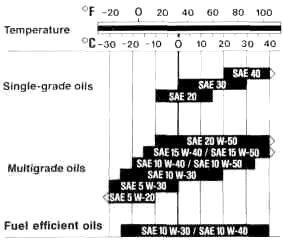 Engine Oils Use only engine oils which meet the specifications designated by PORSCHE. Your Porsche dealer will be glad to advise you on the correct type of oil for your engine. All current engine oils are compatible with each other, i. e. when making an oil change it is not necessary to flush the engine if you wish to use a different brand or grade of oil. Since, however, each brand of oil has a special composition, you should, if possible, use the same oil brand if it becomes necessary to top up between oil changes. PORSCHE engines have long intervals between oil changes. You can make best use of these long oil change intervals by using multigrade oils since these are largely independent of seasonal fluctuations in temperature. |
If your vehicle is used frequently in stop-and-go traffic in winter, the engine will not always be properly warmed up. Condensation from products of combustion may accumulate in the oil. In this case, it is advisable to change the oil in spring so that your engine once again has a 100% efficient engine oil. Engine oil performance class Engine oil is not only a lubricant, but also serves to keep the engine clean, to neutralize the dirt which penetrates into the engine through combustion and to protect the engine against corrosion. To perform these functions, the oil is provided with additives which have been specially developed for these functions. So-called mineral oils are produced directly from crude oil. The oils can be further refined (hydrocrack oils) or totally converted through a number of chemical processes (synthetic oils). These oils are structurally more efficient and require fewer additives than simple mineral oils. The efficiency of an oil is expressed, for example, by the API classifications which are divided into categories "S" and "C". The degrees of quality are expressed by final letters in alphabetical order: The requirements for PORSCHE engines are API class SE/CC to SF/CD. Viscosity Like all liquids, engine oil is viscous when cold, and thin-bodied when warm. |
The viscosity of an oil is expressed by its SAE class. For cold viscosity (measured at temperatures below 0°C) the SAE class is given as a number and the letter "W" (as in winter); for hot viscosity (measured at 100°C) the SAE class is given only as a number. The viscosity of an oil is, therefore, always the same if it has the same number of an SAE class. E. g.: A 10 W-30 oil and a 10 W-40 oil have the same viscosity when cold (below 0°C); when hot (at 100°C) the oil with the number 30 is thinner than the oil with the number 40. Single-grade/multigrade oils Oils with two viscosities are called multi-grade oils; oils with only one viscosity are termed single-grade oils. Single-grade oils can only be used for the narrow temperature range identified by their SAE number; multigrade oils cover a wider temperature range (see chart). Fuel efficient oils Fuel efficient oils reduce internal friction in the engine. PORSCHE approves only fuel efficient oils which are structurally so stable that they can be used in PORSCHE engines both as summer and winter oils (see chart of areas of application for oils of different viscosity). These conditions are currently fulfilled by synthetic or hydrocrack fuel efficient oils. |
||
| 111 | ||||
| Tires, Rims |
944 / 944 S |
| Tires, Rims (Rim offset 52,3 mm) |
215/60 VR 15 front and rear on rims 7 J x 15 H2 or 205/55 VR 16 on 7 J x 16 H2 front and 225/50 VR 16 on 8 J x 16 H2 rear |
| Snow tires (Rim offset 52,3 mm) |
195/65 R 15 80 Q M + S front and rear on rims 7 J x 15 H2 or 215/60 R 15 80 Q M + S front and rear on rims 7 J X 15 H2 or 205/55 R 16 80 Q M + S front and rear on rims 7 J x 16 H2 or 205/55 R 16 80 Q M + S on rims 7 J x 16 H2 front and 225/50 R 16 80 Q M + S on 8 J x 16 H2 rear The load rating and identification letter for allowable maximum speed (e.g. 80 Q/VR 15) represent minimum requirements. |
| Collapsible spare tire | 165-15 8 PR 89 P on rim 51/2 J x 15 H2 Tire pressure always 36 psi (2.5 bar/atm.), front or rear use. Maximum speed is 50 mph (80km/h). |
| Cold tire pressure | front 29 psi (2.0 bar), rear 36 psi (2.5 bar) |
| Snow chains | Should snow chains be necessary, they must be mounted on the drive wheels only. Maximum speed is 30 mph (50 km/h). Always use Porsche - approved snow chains. |
Important hint: For tires with VR quality standard, there are currently no final standards concerning tire strength at speeds above 210 km/h. For this reason, only use tire makes and types tested by Porsche. If you intend to use other than original equipment wheels, be sure that they conform to Porsche specifications for your model. Check with your Porsche dealer regarding the correct wheel specifications for type and model year. |
|
| 112 | |
| Tires, Rims |
944 Turbo | |||
| Tires, Rims (Rim offset 52,3 mm) |
205/55 VR 16 on rims 7 J x 16 H2 front and 225/50 VR 16 on rims 8 J x 16 H2 rear | |||
| Snow tires (Rim offset 52,3 mm) |
205/55 R 16 82 Q M+S on rims 7 J x 16 H2 front and rear or 205/55 R 16 82 Q M + S on rims 7 J x 16 H2 front and 225/50 R 16 82 Q M + S on rims 8 J x 16 H2 rear The load rating and identification letter for allowable maximum speed (e.g. 82 Q/VR 16) represent minimum requirements. |
|||
| Collapsible spare tire | 165-15 8 PR 89 P on rim 51/2 J x 15 H2 Tire pressure always 36 psi (2.5 bar/atm.), front or rear use. Maximum speed is 50 mph (80 km/h). |
|||
| Cold tire pressure | front and rear 36 psi (2.5 bar) | |||
| Snow chains | Should snow chains be necessary, they must be mounted on the drive wheels only. Maximum speed is 30 mph (50 km/h). Always use Porsche - approved snow chains. |
|||
Important hint: For tires with VR quality standard, there are currently no final standards concerning tire strength at speeds above 210 km/h. For this reason, only use tire makes and types tested by Porsche. If you intend to use other than original equipment wheels, be sure that they conform to Porsche specifications for your model. Check with your Porsche dealer regarding the correct wheel specifications for type and model year. |
||||
| 113 | ||||
Dimensions
Weights
* At total permissible weight. ** Do not exceed total permissible weight. *** Applies only if the basic rack of the original Porsche Roof Transport System is used. If old type Porsche ski and luggage racks are used the permissible roof weight is 35 kg (77 Ibs.). The vehicle capacity weight (max. load), the Gross Vehicle Weight Rating (GVWR) and the Gross Axle Weight Ratings (GAWR) for front and rear, are listed on the sticker on the left upper side member in the engine compartment. The gross vehicle weight rating includes the weight of the basic vehicle plus full tank, oil and coolant, plus max. load which combines passenger (150 pounds / 68 kg per designated position) and luggage weight. Luggage weight is not increased by the use of roof, ski or luggage racks, unless passenger capacity is reducted accordingly. |
|||||||
| 114 |
Wheel Alignment
Brake System
Chassis, Suspension
|
|||||||
| 115 |
Performance*
* At curb weight and half-load capacity, excluding optional equipment and accessories. Climbing Performance
|
||||||||||
| 116 |
|
|
| 117 |
| Full-power Curves | 944 | Acceleration Curve Manual gearbox |
944 | |
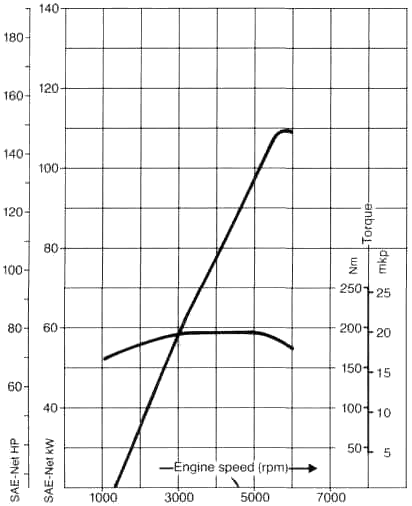 |
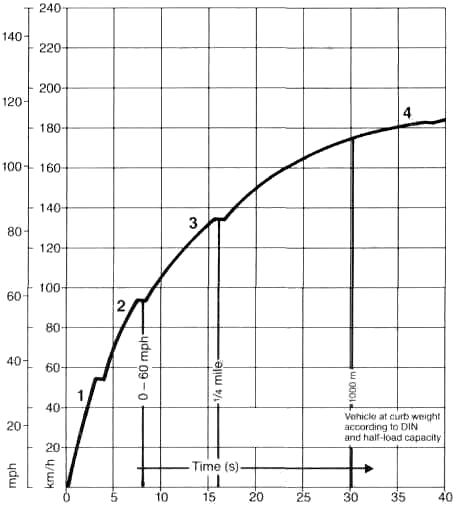 |
|||
| 118 | ||||
| Acceleration Curve Automatic |
944 | |
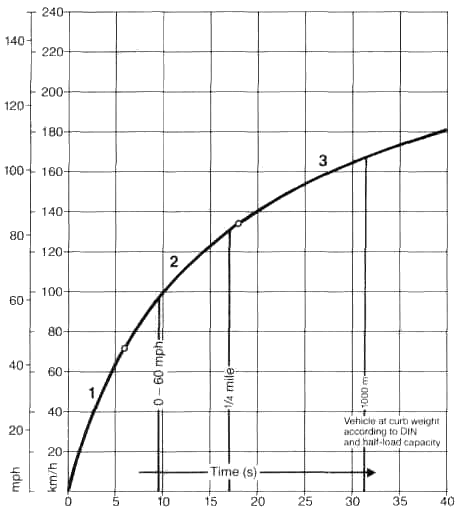 |
||
| 119 | ||
| Full-power Curves | 944S | Acceleration Curve Manual gearbox |
944S | |
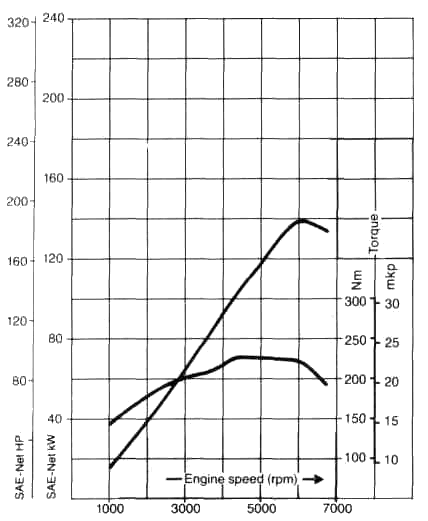 |
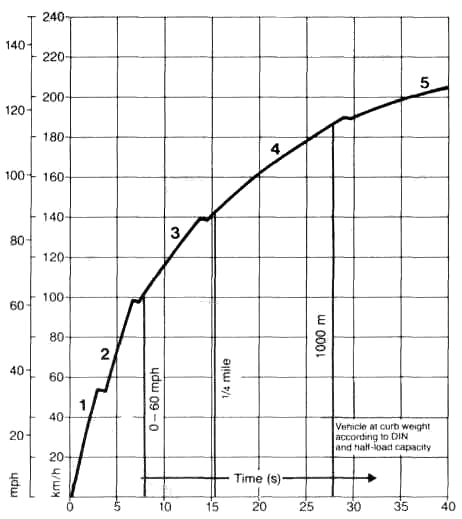 |
|||
| 120 | ||||
| Full-power Curves | 944Turbo | Acceleration Curve Manual gearbox |
944Turbo | |
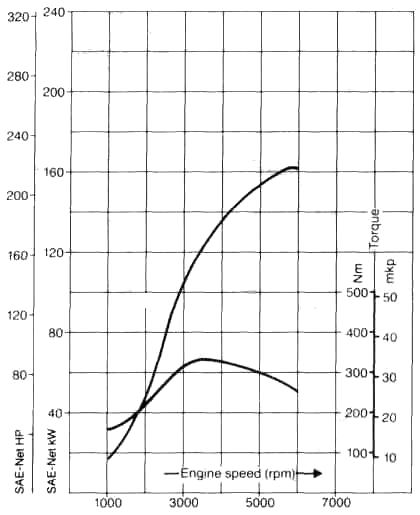 |
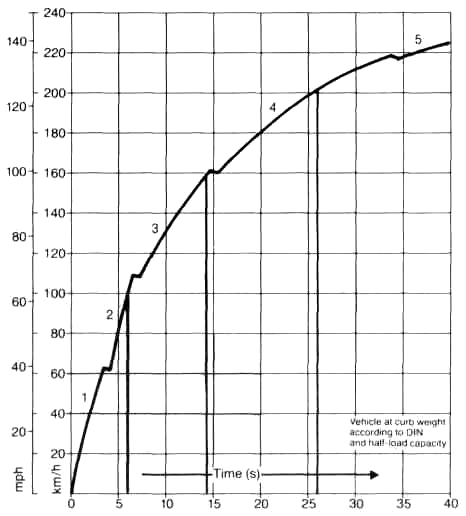 |
|||
| 121 | ||||
| Transmission Diagram Manual gearbox |
944 |
 |
|
| 122 | |
| Transmission Diagram Automatic |
944 |
 |
|
| 123 | |
| Transmission Diagram Manual gearbox |
944S |
 |
|
| 124 | |
| Transmission Diagram Manual gearbox |
944Turbo |
 |
|
| 125 | |
| Gas Station Information |
Fuses and relays The fuses are located within the central electric box at the rear left of the engine compartment in front of the pivot point for the left windshield wiperarm (under black plastic cover). The use of the fuses and relays is shown in a list on the inside of the cover of the fuses and relays. |
Fuel recommendation 944: 91 RON (87 CLC or AKI ((R+M)/2) rating on fuel pumps in U.S.A.) minimum. 944 S / 944 Turbo: 95 RON (90 CLC or AKI ((R+M)/2) rating on fuel pumps in U.S.A.) UNLEADED FUEL ONLY. Fuel tank capacity: 21.1. U.S. gals, or 80 liters. Federal law prohibits use of leaded fuel in this vehicle. |
||||
| Starting Manual transmission: Only start in Neutral, clutch pedal depressed. Automatic transmission: Start in Park. Starting cold or hot engine Just turn ignition key. No need to depress accelerator pedal. Emergency starting Car must not be started by pushing or towing. |
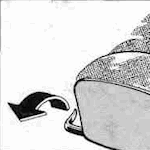 Seat adjustment Pull lever in front of seat. |
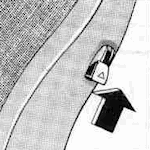 Backrest Lift lever on side of seatback. |
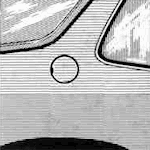 Fuel cap Located in the right rear panel. To close, turn cap clockwise to stop. |
|||
| 126 | ||||||
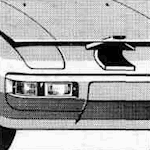 |
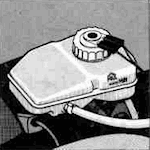 |
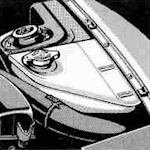 |
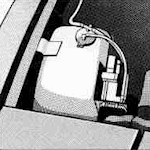 |
|||
| Engine hood release Pull lever on left underneath dashboard. Disengage safety catch and lift engine hood up. Battery In cowl area in engine compartment. Check each cell. Top up with distilled water. Never disconnect battery while engine is running. It can ruin the alternator. Before connecting quick-charger, battery must be disconnected. |
Brake fluid reservoir Level should be between MIN and MAX marks. Only use new brake fluid according to SAE recommendation J 1703, DOT 3 or DOT 4 and conforming to Motor Vehicle Safety Standard 116. Do not use silicone base brake fluid (DOT 5). Even the smallest traces may cause severe corrosion in the brake system. |
Coolant reservoir Antifreeze must remain in cooling system all year round. Coolant level should be between minimum and maximum mark when engine is cold. Always add antifreeze and water in ratio specified under "Filling Capacities". Use quality antifreeze containing ethylene glycol. |
Windshield and headlight washer reservoir 1.6 U.S. gal. or 6.0 liters |
|||
| 127 | ||||||
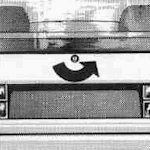 Rear Lid Unlock by turning door/ignition key counter-clockwise or operating the control switch. |
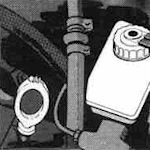 Engine oil dipstick Check oil level a few minutes after engine has stopped. Level should be between upper and lower marks on dipstick. Difference between marks is approx. 1 U.S. qt. or 1 liter. WARNING Before checking anything in the engine compartment, let the engine cool down. The fan blades will rotate spontaneously (even with ignition off) until coolant temperature drops. |
Engine oil Always use quality oil labeled "API" Service "SE or SF". Details under "Engine Oils". With filter change approx. 6.34 U.S. qts. (6.0 liters) 944 Turbo: approx. 6.87 U.S. qts. (6.5 liters) Check oil level as described on "Engine oil level". Manual transmission oil with differential Hypoid oil SAE 80 according to API classification GL 4 or Mil-L 2105. Automatic transmission ATF lubricates torque converter and transmission. Use ATF "Dex-ron®" only. Quantity at oil change: approx. 3 U.S. qts. or 2.8 liters. Check ATF level visually through transparent reservoir at rear end of transmission housing. Difference between marks approx. 1 U.S. pint or 0.4 liter. Check ATF level when ATF is warm, with engine idling, selector lever in Neutral and car on level ground. For differential use oils API/GI 5 (or Mil-L 2105 B), viscosity SAE 90. |
||
| 128 | ||||
 |
Jack support points
Spare tire Under luggage compartment cover Car jack Behind spare tire wheel well under luggage compartment cover Use jack only to change a wheel Never lift car by bumpers Toolkit In right-hand storage well beneath carpet. Tire pressure Cold tire pressures 29 psi (2.0 bar/atm) - front 36 psi (2,5 bar/atm) - front Turbo 36 psi (2,5 bar/atm) - rear Collapsible spare tire front and rear 36 psi (2.5 bar/atm) |
|||
| 127 | ||||